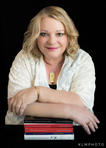Christy K. Robinson's Blog: William & Mary Barrett Dyer--17th century England & New England, page 25
July 30, 2011
Celtic Britain travel journal I
Celtic BritainTRAVEL JOURNAL--part 1
Monday, June 18,2001 —3:30 p.m., Los Angeles
Just settled onto the AirNew Zealand 747 for the 11+ hour flight to Heathrow. Far from getting a CelticBritain preview, a video is playing of sub-tropical New Zealand (thatched Maori houses,tree ferns, placid lagoons at sunset. Well, well — there's Uluru, Ayars Rock.They go to Oz, too.)
So we're on a plane fromthe Antipodes, bound for the"Podes?"
9:50 p.m. LA time — We'vepassed over Newfoundland and are closing in onthe southern tip of Greenland. For hours,we've been traveling with the — well, I thought it was sunset — to ourleft. But the sun just rose out of the "sunset." The video map showsthat we've passed Godthab, Greenland.I'm on a center section aisle seat, so all I see is sky, not land or sea. It'sthe time of summer solstice, and I believe we're a few degrees south of the Arctic Circle.
Tuesday, June 19,2001, 3:00a.m. LA time, 11 a.m. Greenwich time, LONDON!!!
We're off the plane, andon a bus/coach at Heathrow, waiting for the entire party to rendezvous. LaSierra zombies, all. I did verify with the coach driver that it's now Tuesdaythe 19th. Gives new meaning to the hymn, "No More Night."
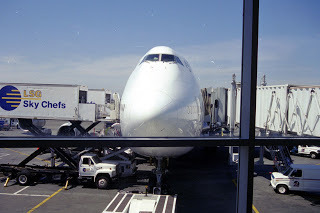 "Ah!" I saidwhen I stepped off the 747 threshold. "I'm returning to the land myancestors left nearly 400 years ago. Breathe deeply of the air!" Far frombeing a Londonpea soup fog, or the bracing salt air of an island, I choked on a lung full ofdiesel and jet fumes.
"Ah!" I saidwhen I stepped off the 747 threshold. "I'm returning to the land myancestors left nearly 400 years ago. Breathe deeply of the air!" Far frombeing a Londonpea soup fog, or the bracing salt air of an island, I choked on a lung full ofdiesel and jet fumes.The coach driver neededMY map to find today's stops. Uh-oh. That's not a good sign. My map is 15 yearsold, but is well marked for all the places I want to see someday. Or on thistrip.
The tree-lined motorway,gently rolling hills, farm buildings, townhouse developments — hmmm… I suspectwe flew around the perimeter of the U.S.,and have been put down in Maryland or Virginia. Just drovepast a brewery delivery truck. Driver could have been Evil Twin of Lance Tyler.Must tell him in next e-mail.
We drove through forestsof pine, hay fields, and green sheep paddocks. (Not for green sheep, thepaddocks are green.) We saw small Quonset huts all over a field, and uponcloser inspection, we found hogs on every doorstep!
All of a sudden, on abroad hill, there was Stonehenge! (I paid£3.50 for admission.) The weather was perfect: breezy, cool, and the cloudswere breaking up. We only had 20 minutes at this place of wonder, so I rushedaround the path. Stonehenge is an awesomemonument, but based on the (probably doctored) photos, it looked a bit squat inperson. Still incredible. I wish we'd had a couple of hours there.
Bus took off for Salisbury immediately. Wesaw many barrows on the hills surrounding Stonehenge,and I was looking for other earthworks. I watched hilltops for evidence ofdigging, which would indicate a hill fort. We drove into the narrow medievalstreets of Salisbury.Still two-way vehicle traffic. We were given 90 minutes to see the cathedralclose and get lunch. I spent 85 minutes there, looking at every effigy andmemorial. (William Longespee/Longsword's effigy adorns the center aisle of the nave.) The carved stone everywhere was amazing, and I appreciate it so muchmore for having read Edward Rutherford's Sarum. I stopped in the TrinityChapel (top of the chancel) and prayed for a few minutes. Many of my Angevinand Plantagenet royal ancestors did the same, I'm sure, though with varieddegrees of devotion.
Then we went to OldSarum, which is an immense hill fort. The ditch and steep bank were dug out andbuilt up by people living here a thousand years before Abraham. What was thisgeneration of monument builders, who built the pyramids of the Middle East and Central America, who dug ramparts of earth, moved sarsenstones scores and hundreds of miles — all with stone, wood, and boneimplements?
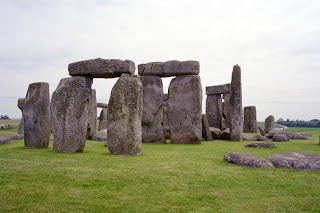 This sense of historywith every footstep and every glance at the countryside, just makes me feel sotiny and humble. No griping about jet lag or burning feet. (Yet.) These peoplecouldn't take an ibuprofen after placing a lintel over a Stonehenge pillar, orsit in a jacuzzi after digging and building (with hands) a hill which wouldtake most of a year for earthmovers and engineers to get accomplished. How didthe Old Ones know to carve a knob on top of the pillar, to securely notch thelintel to the gateway? Who were these visionaries and engineers and slave driversthe ones buried in the barrows? No, I suspect the barrow tombs were only for royalty or priests.
This sense of historywith every footstep and every glance at the countryside, just makes me feel sotiny and humble. No griping about jet lag or burning feet. (Yet.) These peoplecouldn't take an ibuprofen after placing a lintel over a Stonehenge pillar, orsit in a jacuzzi after digging and building (with hands) a hill which wouldtake most of a year for earthmovers and engineers to get accomplished. How didthe Old Ones know to carve a knob on top of the pillar, to securely notch thelintel to the gateway? Who were these visionaries and engineers and slave driversthe ones buried in the barrows? No, I suspect the barrow tombs were only for royalty or priests.It was at least atwo-hour bus ride from Devon north to Avon, but at last (though I could nothelp dozing for five minutes at a time after 40 hours with no sleep), I saw apass in the rolling downs, which would be the south bank of the Severn Valley.We crossed a very long and modern toll bridge, over a muddy "river"that was really a sound or bay, and arrived in Cymru, the Land of the People.My people! My Celtic ancestors moved here when Jerusalem was rebuilt after its Babyloniancaptivity. Our hotel is the NewportHilton. We had a group supper, where Dr. John Jones, one of our two directors,dryly said that after the meal, we should check out the south Wales night clubs. I'm sureeveryone did the same as I: showered for the first time in 40 hours, and sleptfor the first time in about 44-48 hours. (Don't count the nodding on the bus: Iwas forcing myself to stay at least semi-conscious so as not to miss a thing.Many of the tour mates gave up the fight, however!)
I slept for 6 hours andam now awake at 4 a.m. I'm sleepy enough to get another couple hours in beforebreakfast, though.
Wednesday, June 20,2001, 3p.m., Newport,Wales
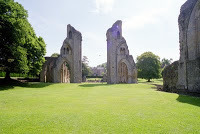 We started the morningwith a buffet breakfast. Then we bused to Glastonburyto see the abbey and cathedral ruins. The weather was perfect: 70, breezy,sunny. I prayed at the grassy place where the high altar would have been, nearthe end of the nave, before the chancel. I stood in the same place as my royalancestors had done.
We started the morningwith a buffet breakfast. Then we bused to Glastonburyto see the abbey and cathedral ruins. The weather was perfect: 70, breezy,sunny. I prayed at the grassy place where the high altar would have been, nearthe end of the nave, before the chancel. I stood in the same place as my royalancestors had done.As we drove out of Glastonbury, we could seethe Tor and its tower on a nearby hill. Some of our group climbed it while therest visited the Abbey. A few miles later, I noticed a hill-fort. They havebanks or terraces to give them an irregular profile. I've noticed 5 or 6 ofthem so far.
I keep noticing square Norman towers every fewmiles. Sometimes there's a church, but not always, if the church burned or felldown. The towers seem to last, though.
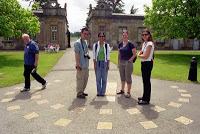 Longleat House: this isthe 16th century manor house of the Marquess of Bath. Grounds byCapability Brown: very natural meadows and lake. But Capability would freak atthe asphalt car and bus park, and the safari rides, gift shop, and ice creamshops. On the house tour, we saw huge paintings and beautiful furniture,although the gigantic windows were all shaded or shuttered so as not to fade ordamage the art treasures. The docents let me take a lift upstairs when they sawmy cane, and kept asking if I was all right. I was halfway down the grandstaircase on my way out, when I heart a docent ask if anyone wanted to play thegrand piano. Suddenly, stairs held no terror for me, and I shot up the steps,offering, "I'll play." I did an improv of "The Water isWide." (Yes, same as I sang in the glow-worm cave at Waitomo, New Zealand.)The ice cream shop had banana and Rolo flavors, so I had an exotic cone forlunch. Penny Shell and I sat on a shaded bench and ate our cones while I rubbedmy sore foot. Then we were off to Bath.
Longleat House: this isthe 16th century manor house of the Marquess of Bath. Grounds byCapability Brown: very natural meadows and lake. But Capability would freak atthe asphalt car and bus park, and the safari rides, gift shop, and ice creamshops. On the house tour, we saw huge paintings and beautiful furniture,although the gigantic windows were all shaded or shuttered so as not to fade ordamage the art treasures. The docents let me take a lift upstairs when they sawmy cane, and kept asking if I was all right. I was halfway down the grandstaircase on my way out, when I heart a docent ask if anyone wanted to play thegrand piano. Suddenly, stairs held no terror for me, and I shot up the steps,offering, "I'll play." I did an improv of "The Water isWide." (Yes, same as I sang in the glow-worm cave at Waitomo, New Zealand.)The ice cream shop had banana and Rolo flavors, so I had an exotic cone forlunch. Penny Shell and I sat on a shaded bench and ate our cones while I rubbedmy sore foot. Then we were off to Bath.I've wanted to see Bath since I first heardof it as a child. Roman mosaics. Magical hot springs. We were let out of our coach by the Avon River,and while others decided what to see first, or who would group with others, Iwas out the door, down the street, and paying for a guided city tour! I was theonly one on the double-deck bus, so the tour guide just told it all to me. Bath has narrow, curvingstreets lined with Edwardian-era tan limestone tenements. I don't mean thatthey were a slum. Just every one alike. Thousands, all alike! I went first tothe abbey church, and read a few memorial carvings in the floor. The carvingsall face east, same as Salisbury,so I believe it's so that at the Resurrection, the bodies will all come upfacing Jesus? The organist was practicing, and it still sounded great.
Found the Adventistchurch, literally in the shadow of the abbey church. About as small as agarage. Left my LSU business card in the letter slot, for the pastor to find atprayer meeting that evening.
Then I went to the RomanBath and museum. It was very interesting and lived up to all but one dream: tosoak my aching feet or dangle them in a hot spring pool. The archaeologicalsociety could have a spa concession, like 50p or £1 to let you unshoe, and rollup your pants legs, and dunk! Walking up and down stairs, and across stoneblocks, and concrete — aieeeee, my feet.
Searched desperately fora sandwich shop for supper, since I'd only had the cone for lunch. They roll upthe sidewalks at 6, though, and it was 6:15 when I was needing sustenance and atall drink. Finally found a tuna salad to go, after hobbling back and forth onthe cobblestones, and then I made it back to the coach for the 90-minute tripback to the hotel.
It's 9:35 p.m. here in Wales,and the sun is just now setting and it's getting chilly out here in the hotelcourtyard. There's a fountain splashing, and the birds are singing. Maybe I'llgo in and soak my feet in a hot bath: the porcelain tub and tap water. Tomorrowis New Moon and summer solstice, here in neo-druid headquarters. There'ssupposed to be a world-wide voluntary "rolling blackout" to make people awareof and encourage participation in energy conservation. Jay Leno will do hisshow in candlelight tomorrow night.
Thursday, June 21,2001, 7p.m., Cornwall
We're rolling across themoors of Devon and Cornwall.The sun is still high in the western sky, with two and a half hours ofbenevolent smiles left in this longest day of the year. Back in my hometown of Phoenix, there's no reasonto celebrate the long, blasting hot day, when the earth is closest to the sun andtilted toward Old Sol at the same time. And who thought up Midsummer's Eve,when there are still three-plus months of hellish heat to go? Dang! But here inBritain,I can at last understand reveling in the perfect day. There are sheep andcattle on every hillside, either grazing, ruminating, or shamelessly stretchedout for a snooze. Clear sky, green grass, fields of red poppies, the occasionalpuffy cloud…. Very nice.
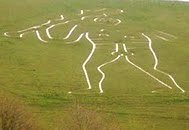 We left Newport,Wales,and took small, narrow lanes to get to Cerne Abbas in Dorsetshire to see theChalk Giant. (I think our driver would have got there 45-60 minutes earlier ifhe knew where he's going, and drove faster. We are the slowest vehicle on theroad.) The Giant is a warrior with a 120-foot-long war club, and (let's not gothere for the length!) an erect penis, cavorting on a hillside in Dorset. He could be Celtic and Iron Age, orHercules/Helios ca 275 AD, or an 18th century invention.
We left Newport,Wales,and took small, narrow lanes to get to Cerne Abbas in Dorsetshire to see theChalk Giant. (I think our driver would have got there 45-60 minutes earlier ifhe knew where he's going, and drove faster. We are the slowest vehicle on theroad.) The Giant is a warrior with a 120-foot-long war club, and (let's not gothere for the length!) an erect penis, cavorting on a hillside in Dorset. He could be Celtic and Iron Age, orHercules/Helios ca 275 AD, or an 18th century invention. We poked our way throughthe rural valleys and across moors. Dorset and Devon were part of the kingdom of Wessex, where Alfred the Great (myancestor) ruled. I read aloud parts of a chapter on Alfred and his Welsh(Celtic) teacher. After more sheep, more cattle, a drive through the southerntown of Bridgport,we headed northwest past (oh, yes) more sheep, cattle, and moors. Not onesingle part was ugly or blighted—it was all beautiful. I suggested we stop fora cream tea, since this place has a world-famous reputation for clotted cream,so we started looking for a tea room. We stopped at Camelford Bridge,the site of King Arthur's last battle, where he was killed by Mordred. Wewalked 300 yards (seemed a lot farther, though) down a gravel path to thefamous bridge, and then had Cornish cream tea at the little tea room. Two smallscones, clotted cream, jam, and a pot of tea. Very nice.
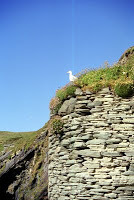 About 7 miles more, andwe were in Tintagel, a clifftop village. The castle there, actually built byReginald, illegitimate son of Henry I, is supposedly Arthur's birthplace,although why anyone would be born on a cliff 600 years before the castle wasbuilt, is beyond me! The existing ruins are on a wild crag of coastline. I paida pound to ride a Land Rover down to the base of the castle stairs, but therewas no way I was traipsing up or down hundreds of steps. I stayed by the littlestream/waterfall above the cove, with its booming surf, and took some picturesof Kit and Penny and various seabirds. Just before our time was up, I bought abeef pasty, a world-famous Cornish specialty. I even influenced several othersto try pasties. We boarded the bus for the three-hour trip back to Newport. We pasty-eaterssampled the huge pies after 9:30, and everyone really liked them.
About 7 miles more, andwe were in Tintagel, a clifftop village. The castle there, actually built byReginald, illegitimate son of Henry I, is supposedly Arthur's birthplace,although why anyone would be born on a cliff 600 years before the castle wasbuilt, is beyond me! The existing ruins are on a wild crag of coastline. I paida pound to ride a Land Rover down to the base of the castle stairs, but therewas no way I was traipsing up or down hundreds of steps. I stayed by the littlestream/waterfall above the cove, with its booming surf, and took some picturesof Kit and Penny and various seabirds. Just before our time was up, I bought abeef pasty, a world-famous Cornish specialty. I even influenced several othersto try pasties. We boarded the bus for the three-hour trip back to Newport. We pasty-eaterssampled the huge pies after 9:30, and everyone really liked them.See Celtic Britain Travel Journal Part 2 in this blog. (Coming up: Ireland)
Published on July 30, 2011 11:49
July 12, 2011
Celtic Britain--my first tour of the UK
I wrote this article in July 2001, upon my return from a university tour of England, Wales, Ireland, Northern Ireland, and Scotland. This was the first of four (so far) extended trips to the UK. A joint effort of the English and religion departments, the tour members prepared research papers beforehand, and presented them to the "class" during extended coach trips. This article was published in La Sierra Today magazine in December 2001. There was also a travel journal, which I'll publish to this blog separately.
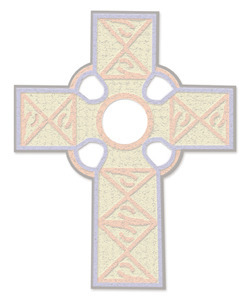 The Celtic cross, with its circle behind the cross beams, symbolizes the eternity of God.
The Celtic cross, with its circle behind the cross beams, symbolizes the eternity of God.
May those who love us, love us,And those who don't love us,May God turn their hearts;And if He doesn't turn their heartsMay he turn their anklesSo we'll know them by their limping.(old Celtic blessing)
I admit, I limped. A lot. But I have a note from my doctor, so don't tattle to my pastor. (Besides, she's seen me with my walking stick.) There were times I felt like roadkill, after a long day of pounding the cobblestones or dragging up six flights of un-air-conditioned stairs to get to the Celtic Britain display in the British Museum. The castles or cathedrals we visited were always at the hill's crown (for defensive purposes), often surrounded by an ancient stone wall (and we had to leave the bus at the bottom of the mount). But no one did it to me: it was my choice. And my clothes are much looser after all that exercise, so who's complaining?
The trip was a class for some, and business for several others. So I probably shouldn't mention that it was fun. The IRS or the academic vice president might take exception to our claims.
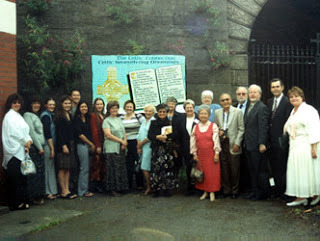 The Celtic Britain tour group visited a church in Dublin, Ireland.
The Celtic Britain tour group visited a church in Dublin, Ireland.
The Celtic Britain 2001 tour, June 18 to July 3, was offered for academic credit in both religion and English departments. Students researched and wrote papers before the trip, and presented them from the jump seat at the front of the coach. Non-academic tour members were educated right along with the students. There were twenty-two tour members, including directors Dorothy Minchin Comm, PhD, professor of English, and John Jones, PhD, professor and dean of the School of Religion.
We were an eclectic bunch: retired medical missionaries, university grad students, the two directors of the LSU Women's Resource Center, elementary school teachers, nurses, an actor, musicians, history buffs. Seasoned travelers and first-timers. One had hardly been out of her small town, and was terrified of her first trip on a ferry across the Irish Sea. Soon she was savoring the sea air, something like Funny Girl singing, "Don't rain on my parade," thanks to the helpful and encouraging attitude of her new friends. Some of us stayed grouped together in twos or threes, others ran out the door alone.
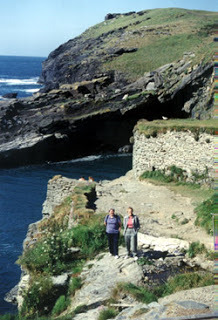 Kit Watts and Penny Shell enjoyed the summer solstice at Tintagel, Cornwall.We visited places we'd read about all our lives, from books or magazines on history, art, culture, and religion. Stonehenge was our first stop, and the thirteenth-century Salisbury Cathedral was our second. The architecture of cathedrals, castles, and Neolithic hillforts were equally stunning. We went to sites as diverse as southeastern England, Cornwall, Wales, Republic of Ireland, Northern Ireland, Scotland, and back into central England. In Wales, we found a stone circle in a traffic roundabout.
Kit Watts and Penny Shell enjoyed the summer solstice at Tintagel, Cornwall.We visited places we'd read about all our lives, from books or magazines on history, art, culture, and religion. Stonehenge was our first stop, and the thirteenth-century Salisbury Cathedral was our second. The architecture of cathedrals, castles, and Neolithic hillforts were equally stunning. We went to sites as diverse as southeastern England, Cornwall, Wales, Republic of Ireland, Northern Ireland, Scotland, and back into central England. In Wales, we found a stone circle in a traffic roundabout.
Our mission was to walk in the footsteps of the Celtic saints, David of Wales, Bridget, Patrick, Ciaran, Columcille/Columba, Brendan the Navigator, Cuthbert, and many others. Those footsteps included the monasteries at Clonfert and Clonmacnoise, Glastonbury, Iona and Lindisfarne, Downpatrick, and Glendalough, as well as the tiny 1600 year-old drymasonry oratory of Gallarus. The saints, of course, have many miraculous and (frankly too-fabulous) legendary feats attributed to them. In fact, they were pioneer missionaries to the pagan Celtic and Saxon settlers in the British Isles. They fearlessly risked their lives to preach the Gospel to some very wild, sometimes savage pagans!
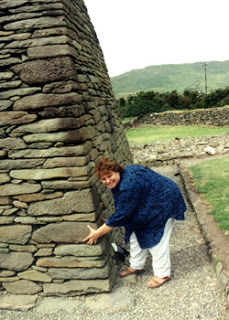 1600-year-old Gallarus Oratory, Dingle, Ireland.We saw the original Book of Kells (illuminated Gospels) in Dublin, and a Magna Carta in Salisbury. We walked through stone cells where the Gospels were laboriously copied and illuminated with fanciful animals and Celtic Christian symbols. What would be the quality of our work, if we thought that it would be scrutinized and appreciated 1200 years from now? La Sierra Today in a climate-controlled Plexiglass box, with hundreds of pilgrims lined up daily to pay their £4 admission ticket? I wish!
1600-year-old Gallarus Oratory, Dingle, Ireland.We saw the original Book of Kells (illuminated Gospels) in Dublin, and a Magna Carta in Salisbury. We walked through stone cells where the Gospels were laboriously copied and illuminated with fanciful animals and Celtic Christian symbols. What would be the quality of our work, if we thought that it would be scrutinized and appreciated 1200 years from now? La Sierra Today in a climate-controlled Plexiglass box, with hundreds of pilgrims lined up daily to pay their £4 admission ticket? I wish!
We found the tiny Adventist church, literally in the shadow of the large Bath Abbey. We worshiped with fellow believers in churches in Dublin and Edinburgh. Members of the tour took parts of the services there, giving prayer or special music, and even the sermon. We had devotions on the coach, rolling across the green, sheep-dotted moors of Cornwall, past the Norman keeps and church towers of Wales, and the medieval city walls of Ireland. I committed myself to silently praying before the altar of every church or cathedral or abbey that we visited.
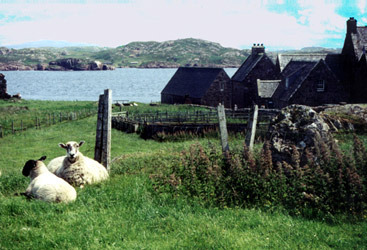 "Wear British Wool: 40 Million Sheep Can't Be Wrong," said a bumper sticker. Island of Iona, off the west coast of Scotland.
"Wear British Wool: 40 Million Sheep Can't Be Wrong," said a bumper sticker. Island of Iona, off the west coast of Scotland.
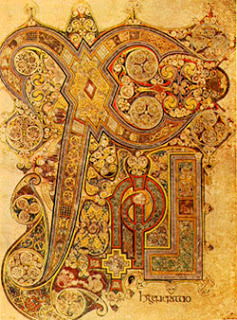 Chi-Ro carpet page from Book of KellsThose were the high points of my experience, really. It's hard to choose which place was more beautiful or perfect than the last. The 1500 year-old Clonfert cathedral was tiny and dark, with birds flying in the rafters above, and electric space heaters stored in the vestry. Glastonbury was immense, but roofed in blue sky and carpeted in grass. My ancestors prayed and took Communion 840 years ago, in that place, when it stood in all its glory. St. Margaret's Chapel, a tiny barrel-vaulted chapel on the rock at Edinburgh Castle, was dedicated to Queen Margaret by her son and my ancestor, David I of Scotland. Two generations of my Neville ancestors were interred at Durham Cathedral, the largest medieval building in Britain. I took Communion at Westminster Abbey, where other ancestors were crowned or buried; and at St. Paul's, a monument to God's glory. Holy places, all, for more than a millennium. Hard to fathom, when you're native to the American Southwest, really only habitable since the advent of air conditioning.
Chi-Ro carpet page from Book of KellsThose were the high points of my experience, really. It's hard to choose which place was more beautiful or perfect than the last. The 1500 year-old Clonfert cathedral was tiny and dark, with birds flying in the rafters above, and electric space heaters stored in the vestry. Glastonbury was immense, but roofed in blue sky and carpeted in grass. My ancestors prayed and took Communion 840 years ago, in that place, when it stood in all its glory. St. Margaret's Chapel, a tiny barrel-vaulted chapel on the rock at Edinburgh Castle, was dedicated to Queen Margaret by her son and my ancestor, David I of Scotland. Two generations of my Neville ancestors were interred at Durham Cathedral, the largest medieval building in Britain. I took Communion at Westminster Abbey, where other ancestors were crowned or buried; and at St. Paul's, a monument to God's glory. Holy places, all, for more than a millennium. Hard to fathom, when you're native to the American Southwest, really only habitable since the advent of air conditioning.
But my favorite place was the tiny, tidal island of Lindisfarne, off the North Yorkshire coast. The coach drove across the causeway scant minutes before the tide stranded us on the island for more than three hours. The rest of the group were scattered around the castle, town, and museum, and I was alone in the priory church. Again, it was green grass below and blue sky above. The afternoon sun shone through glassless windows, as I sat to rest on a low stone wall at the center of the chancel, and thanked God for bringing me to this sacred place. In my spirit, I heard, "Present yourself as a living sacrifice, holy and pleasing to God. This is your spiritual act of worship." I knew it was God speaking, but why here, and why that text from Romans? I realized I was sitting at the very place where the stone altar had been placed in 600 AD. How many opportunities does one have in a lifetime, to be sacrificed on a stone altar? Thanks be to God, we are living sacrifices!
The trip was a religious experience for all of us, at some points. Who could not be impressed by the dedication of the pioneer missionaries and saints? Who could not hear God in the organ of a colossal cathedral or the peace of an ancient churchyard on Iona? Who could fail to see His handiwork in a brilliant rainbow shining over a Scottish loch? Who could miss the symbolism of a white dove perched on the stone arch of a ruined abbey?
But one could not ignore the anticipatory shiver as the bagpipers marched through the gates at Edinburgh Castle, the thrill of the chill wind and stray rain drops in your hair as you coasted on a rented bike down a hillside, or the growling stomach when it was overdue for that Cornish pasty you promised it three hours ago. Answering your email from an Internet café in Cork, Ireland, has a certain boast built in ("I'm in Ireland, and you're not"), even if you try to sound humble!
You could find your own joys and shivers and introspective moments, even plenty of Kodak moments, on other trips offered by La Sierra University. This year [2001], the University sponsored trips to South America, South Africa, the Mediterranean, the Holy Land. Modern Languages sent students to Paris and Central America. In 2002, LSU President Lawrence T. Geraty, director of the Madaba Plains Project, will lead an archaeological dig in Jordan. (I'm planning on that one!) And there will be others, as well. How about China and Asia? You'll learn as much from your own and fellow students' experiences as you do from the professors who are expert in their fields.
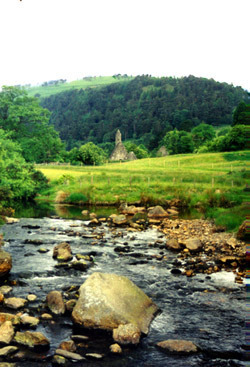 Glendalough, Republic of IrelandThe trips are not cheap, but neither are the memories. My scrapbook weighs 20 pounds! And if you start saving and sacrificing now for next year, you could do it. Sure, on the trip you'll have to wear the same few outfits over and over, drench them with Febreze fabric deodorizer, and wash them in the hotel bathtub. You'll try new and sometimes bizarre dishes in restaurants. You'll be crammed into a jet plane, and wish vainly that your bus could stop and let you have a still picture for once, instead of madly dashing to meet the ferry. You could ride a real bike, not the stationary kind. Your bags will be sniffed by dogs and maybe even some stern-looking security agents. You will put significant mileage on those athletic shoes, so put gel inserts in them. Take your ATM card to draw foreign currency there. Be sure to take your walking stick, no matter where you go or how fit you are. After I walked two miles to arrive at all those stairs at Clifford's Tower in York, my knees were jelly, and I still had miles to go that day!
Glendalough, Republic of IrelandThe trips are not cheap, but neither are the memories. My scrapbook weighs 20 pounds! And if you start saving and sacrificing now for next year, you could do it. Sure, on the trip you'll have to wear the same few outfits over and over, drench them with Febreze fabric deodorizer, and wash them in the hotel bathtub. You'll try new and sometimes bizarre dishes in restaurants. You'll be crammed into a jet plane, and wish vainly that your bus could stop and let you have a still picture for once, instead of madly dashing to meet the ferry. You could ride a real bike, not the stationary kind. Your bags will be sniffed by dogs and maybe even some stern-looking security agents. You will put significant mileage on those athletic shoes, so put gel inserts in them. Take your ATM card to draw foreign currency there. Be sure to take your walking stick, no matter where you go or how fit you are. After I walked two miles to arrive at all those stairs at Clifford's Tower in York, my knees were jelly, and I still had miles to go that day!
I'm afraid those modern Britons knew me by my limping, but it wasn't my unloving attitude. (It was my 1982 accident.) This was a journey I've wanted to make since I was a teenager, and that was several dog-years ago. I can hardly wait for Jordan in July 2002. Maybe Israel or St. Paul's journeys the year after. There are still blank pages in my passport, and I can buy new tips for my walking stick!

 The Celtic cross, with its circle behind the cross beams, symbolizes the eternity of God.
The Celtic cross, with its circle behind the cross beams, symbolizes the eternity of God.May those who love us, love us,And those who don't love us,May God turn their hearts;And if He doesn't turn their heartsMay he turn their anklesSo we'll know them by their limping.(old Celtic blessing)
I admit, I limped. A lot. But I have a note from my doctor, so don't tattle to my pastor. (Besides, she's seen me with my walking stick.) There were times I felt like roadkill, after a long day of pounding the cobblestones or dragging up six flights of un-air-conditioned stairs to get to the Celtic Britain display in the British Museum. The castles or cathedrals we visited were always at the hill's crown (for defensive purposes), often surrounded by an ancient stone wall (and we had to leave the bus at the bottom of the mount). But no one did it to me: it was my choice. And my clothes are much looser after all that exercise, so who's complaining?
The trip was a class for some, and business for several others. So I probably shouldn't mention that it was fun. The IRS or the academic vice president might take exception to our claims.
 The Celtic Britain tour group visited a church in Dublin, Ireland.
The Celtic Britain tour group visited a church in Dublin, Ireland.The Celtic Britain 2001 tour, June 18 to July 3, was offered for academic credit in both religion and English departments. Students researched and wrote papers before the trip, and presented them from the jump seat at the front of the coach. Non-academic tour members were educated right along with the students. There were twenty-two tour members, including directors Dorothy Minchin Comm, PhD, professor of English, and John Jones, PhD, professor and dean of the School of Religion.
We were an eclectic bunch: retired medical missionaries, university grad students, the two directors of the LSU Women's Resource Center, elementary school teachers, nurses, an actor, musicians, history buffs. Seasoned travelers and first-timers. One had hardly been out of her small town, and was terrified of her first trip on a ferry across the Irish Sea. Soon she was savoring the sea air, something like Funny Girl singing, "Don't rain on my parade," thanks to the helpful and encouraging attitude of her new friends. Some of us stayed grouped together in twos or threes, others ran out the door alone.
 Kit Watts and Penny Shell enjoyed the summer solstice at Tintagel, Cornwall.We visited places we'd read about all our lives, from books or magazines on history, art, culture, and religion. Stonehenge was our first stop, and the thirteenth-century Salisbury Cathedral was our second. The architecture of cathedrals, castles, and Neolithic hillforts were equally stunning. We went to sites as diverse as southeastern England, Cornwall, Wales, Republic of Ireland, Northern Ireland, Scotland, and back into central England. In Wales, we found a stone circle in a traffic roundabout.
Kit Watts and Penny Shell enjoyed the summer solstice at Tintagel, Cornwall.We visited places we'd read about all our lives, from books or magazines on history, art, culture, and religion. Stonehenge was our first stop, and the thirteenth-century Salisbury Cathedral was our second. The architecture of cathedrals, castles, and Neolithic hillforts were equally stunning. We went to sites as diverse as southeastern England, Cornwall, Wales, Republic of Ireland, Northern Ireland, Scotland, and back into central England. In Wales, we found a stone circle in a traffic roundabout.Our mission was to walk in the footsteps of the Celtic saints, David of Wales, Bridget, Patrick, Ciaran, Columcille/Columba, Brendan the Navigator, Cuthbert, and many others. Those footsteps included the monasteries at Clonfert and Clonmacnoise, Glastonbury, Iona and Lindisfarne, Downpatrick, and Glendalough, as well as the tiny 1600 year-old drymasonry oratory of Gallarus. The saints, of course, have many miraculous and (frankly too-fabulous) legendary feats attributed to them. In fact, they were pioneer missionaries to the pagan Celtic and Saxon settlers in the British Isles. They fearlessly risked their lives to preach the Gospel to some very wild, sometimes savage pagans!
 1600-year-old Gallarus Oratory, Dingle, Ireland.We saw the original Book of Kells (illuminated Gospels) in Dublin, and a Magna Carta in Salisbury. We walked through stone cells where the Gospels were laboriously copied and illuminated with fanciful animals and Celtic Christian symbols. What would be the quality of our work, if we thought that it would be scrutinized and appreciated 1200 years from now? La Sierra Today in a climate-controlled Plexiglass box, with hundreds of pilgrims lined up daily to pay their £4 admission ticket? I wish!
1600-year-old Gallarus Oratory, Dingle, Ireland.We saw the original Book of Kells (illuminated Gospels) in Dublin, and a Magna Carta in Salisbury. We walked through stone cells where the Gospels were laboriously copied and illuminated with fanciful animals and Celtic Christian symbols. What would be the quality of our work, if we thought that it would be scrutinized and appreciated 1200 years from now? La Sierra Today in a climate-controlled Plexiglass box, with hundreds of pilgrims lined up daily to pay their £4 admission ticket? I wish!We found the tiny Adventist church, literally in the shadow of the large Bath Abbey. We worshiped with fellow believers in churches in Dublin and Edinburgh. Members of the tour took parts of the services there, giving prayer or special music, and even the sermon. We had devotions on the coach, rolling across the green, sheep-dotted moors of Cornwall, past the Norman keeps and church towers of Wales, and the medieval city walls of Ireland. I committed myself to silently praying before the altar of every church or cathedral or abbey that we visited.
 "Wear British Wool: 40 Million Sheep Can't Be Wrong," said a bumper sticker. Island of Iona, off the west coast of Scotland.
"Wear British Wool: 40 Million Sheep Can't Be Wrong," said a bumper sticker. Island of Iona, off the west coast of Scotland.
 Chi-Ro carpet page from Book of KellsThose were the high points of my experience, really. It's hard to choose which place was more beautiful or perfect than the last. The 1500 year-old Clonfert cathedral was tiny and dark, with birds flying in the rafters above, and electric space heaters stored in the vestry. Glastonbury was immense, but roofed in blue sky and carpeted in grass. My ancestors prayed and took Communion 840 years ago, in that place, when it stood in all its glory. St. Margaret's Chapel, a tiny barrel-vaulted chapel on the rock at Edinburgh Castle, was dedicated to Queen Margaret by her son and my ancestor, David I of Scotland. Two generations of my Neville ancestors were interred at Durham Cathedral, the largest medieval building in Britain. I took Communion at Westminster Abbey, where other ancestors were crowned or buried; and at St. Paul's, a monument to God's glory. Holy places, all, for more than a millennium. Hard to fathom, when you're native to the American Southwest, really only habitable since the advent of air conditioning.
Chi-Ro carpet page from Book of KellsThose were the high points of my experience, really. It's hard to choose which place was more beautiful or perfect than the last. The 1500 year-old Clonfert cathedral was tiny and dark, with birds flying in the rafters above, and electric space heaters stored in the vestry. Glastonbury was immense, but roofed in blue sky and carpeted in grass. My ancestors prayed and took Communion 840 years ago, in that place, when it stood in all its glory. St. Margaret's Chapel, a tiny barrel-vaulted chapel on the rock at Edinburgh Castle, was dedicated to Queen Margaret by her son and my ancestor, David I of Scotland. Two generations of my Neville ancestors were interred at Durham Cathedral, the largest medieval building in Britain. I took Communion at Westminster Abbey, where other ancestors were crowned or buried; and at St. Paul's, a monument to God's glory. Holy places, all, for more than a millennium. Hard to fathom, when you're native to the American Southwest, really only habitable since the advent of air conditioning. But my favorite place was the tiny, tidal island of Lindisfarne, off the North Yorkshire coast. The coach drove across the causeway scant minutes before the tide stranded us on the island for more than three hours. The rest of the group were scattered around the castle, town, and museum, and I was alone in the priory church. Again, it was green grass below and blue sky above. The afternoon sun shone through glassless windows, as I sat to rest on a low stone wall at the center of the chancel, and thanked God for bringing me to this sacred place. In my spirit, I heard, "Present yourself as a living sacrifice, holy and pleasing to God. This is your spiritual act of worship." I knew it was God speaking, but why here, and why that text from Romans? I realized I was sitting at the very place where the stone altar had been placed in 600 AD. How many opportunities does one have in a lifetime, to be sacrificed on a stone altar? Thanks be to God, we are living sacrifices!
The trip was a religious experience for all of us, at some points. Who could not be impressed by the dedication of the pioneer missionaries and saints? Who could not hear God in the organ of a colossal cathedral or the peace of an ancient churchyard on Iona? Who could fail to see His handiwork in a brilliant rainbow shining over a Scottish loch? Who could miss the symbolism of a white dove perched on the stone arch of a ruined abbey?
But one could not ignore the anticipatory shiver as the bagpipers marched through the gates at Edinburgh Castle, the thrill of the chill wind and stray rain drops in your hair as you coasted on a rented bike down a hillside, or the growling stomach when it was overdue for that Cornish pasty you promised it three hours ago. Answering your email from an Internet café in Cork, Ireland, has a certain boast built in ("I'm in Ireland, and you're not"), even if you try to sound humble!
You could find your own joys and shivers and introspective moments, even plenty of Kodak moments, on other trips offered by La Sierra University. This year [2001], the University sponsored trips to South America, South Africa, the Mediterranean, the Holy Land. Modern Languages sent students to Paris and Central America. In 2002, LSU President Lawrence T. Geraty, director of the Madaba Plains Project, will lead an archaeological dig in Jordan. (I'm planning on that one!) And there will be others, as well. How about China and Asia? You'll learn as much from your own and fellow students' experiences as you do from the professors who are expert in their fields.
 Glendalough, Republic of IrelandThe trips are not cheap, but neither are the memories. My scrapbook weighs 20 pounds! And if you start saving and sacrificing now for next year, you could do it. Sure, on the trip you'll have to wear the same few outfits over and over, drench them with Febreze fabric deodorizer, and wash them in the hotel bathtub. You'll try new and sometimes bizarre dishes in restaurants. You'll be crammed into a jet plane, and wish vainly that your bus could stop and let you have a still picture for once, instead of madly dashing to meet the ferry. You could ride a real bike, not the stationary kind. Your bags will be sniffed by dogs and maybe even some stern-looking security agents. You will put significant mileage on those athletic shoes, so put gel inserts in them. Take your ATM card to draw foreign currency there. Be sure to take your walking stick, no matter where you go or how fit you are. After I walked two miles to arrive at all those stairs at Clifford's Tower in York, my knees were jelly, and I still had miles to go that day!
Glendalough, Republic of IrelandThe trips are not cheap, but neither are the memories. My scrapbook weighs 20 pounds! And if you start saving and sacrificing now for next year, you could do it. Sure, on the trip you'll have to wear the same few outfits over and over, drench them with Febreze fabric deodorizer, and wash them in the hotel bathtub. You'll try new and sometimes bizarre dishes in restaurants. You'll be crammed into a jet plane, and wish vainly that your bus could stop and let you have a still picture for once, instead of madly dashing to meet the ferry. You could ride a real bike, not the stationary kind. Your bags will be sniffed by dogs and maybe even some stern-looking security agents. You will put significant mileage on those athletic shoes, so put gel inserts in them. Take your ATM card to draw foreign currency there. Be sure to take your walking stick, no matter where you go or how fit you are. After I walked two miles to arrive at all those stairs at Clifford's Tower in York, my knees were jelly, and I still had miles to go that day!I'm afraid those modern Britons knew me by my limping, but it wasn't my unloving attitude. (It was my 1982 accident.) This was a journey I've wanted to make since I was a teenager, and that was several dog-years ago. I can hardly wait for Jordan in July 2002. Maybe Israel or St. Paul's journeys the year after. There are still blank pages in my passport, and I can buy new tips for my walking stick!
Published on July 12, 2011 16:14
July 5, 2011
Pirates in your face! Helen Hollick guest post
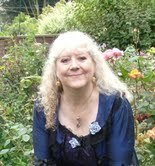 Helen Hollick, author I am honored to present to my readers a guest article by historical fiction author Helen Hollick. She's a prolific writer in the history/historical fiction genre I enjoy most, and I've come to enjoy her acquaintance with Facebook and email exchanges. I have her Harold the King/I Am the Chosen King book on Kindle for PC and am fascinated by her portrayal of that ancestor.
Helen Hollick, author I am honored to present to my readers a guest article by historical fiction author Helen Hollick. She's a prolific writer in the history/historical fiction genre I enjoy most, and I've come to enjoy her acquaintance with Facebook and email exchanges. I have her Harold the King/I Am the Chosen King book on Kindle for PC and am fascinated by her portrayal of that ancestor. Hollick's Sea Witch Voyages series of books is being republished by SilverWood Books, and I was excited to discover another tie to my (and your, if you found Spotswood in a search) ancestors. She's written pirate novels that features our pirate-stalking ancestor, Governor Alexander Spotswood of Virginia, as one of her characters. I'll let Helen explain from here. See my further note at the end of her article and discover an opportunity to win a book from Helen.
Bring It Close: pirates in your face!by Helen Hollick

Hello. I'm probably more well known in the US for my serious historical fiction novels – The Pendragon's Banner Trilogy, Forever Queen, and I am the Chosen King (titled A Hollow Crown and Harold the King here in the UK). Indeed I was most thrilled a few weeks ago to discover that Forever Queen had made it into the USA Today Bestseller list.
I also write a series of historical adventure fantasy – the Sea Witch Voyages. I describe these as a typical sailor's yarn, a blend of Sharpe, Hornblower, James Bond and Indiana Jones – with a dash of Jack Sparrow!
They are meant as light-hearted entertainment (fun for me to write and for readers to enjoy). I suppose they are more supernatural than fantasy, for although the female lead, Tiola Oldstaff (pronounced Te-ola Oldstaff) is a white witch, I think of her Craft more as the Force in Star Wars, not Harry Potter wizardry. My main character, Captain Jesamiah Acorne, is a charmer of a rogue. Handsome, brave, bold, quick to laugh, formidable when angry; one for the ladies – a pirate! In the first three Voyages – Sea Witch, Pirate Code and Bring It Close, he finds himself in all sorts of scrapes, from almost being killed by his jealous half brother, to spying on the Spanish and having a desperate run-in with Edward Teach – Blackbeard himself. Trouble follows Jesamiah like a ship's wake! I'm writing a fourth in the series, Ripples in the Sand.
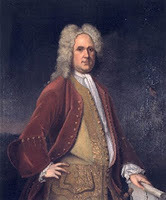 Lt Col Alexander SpotswoodIt was very interesting hearing from Christy – and being invited onto this Blog - because she is a ninth-generation direct descendent of Lieutenant Colonel Alexander Spotswood, who was Governor of Virginia from 1710-1722.
Lt Col Alexander SpotswoodIt was very interesting hearing from Christy – and being invited onto this Blog - because she is a ninth-generation direct descendent of Lieutenant Colonel Alexander Spotswood, who was Governor of Virginia from 1710-1722. The Governor's father, Dr. Robert Spotswood, was surgeon to the British military post in Tangiers, Morocco; his grandfather, Sir Robert Spotswood, a Privy Councillor to King Charles I, was executed by Cromwell's Parliamentarians during the English Civil War. Governor Spotswood's great-grandfather John Spottiswoode was the Archbishop of Scotland and Chancellor to King Charles I, and is buried in Westminster Abbey. [See Westminster Abbey's page on John Spottiswoode: http://www.westminster-abbey.org/our-history/people/john-spottiswood.] Alexander Spotswood not only had his own illustrious lineage, but his wife's goes back to Norman and Scottish royalty and nobility.
Spotsylvania County, Virginia, is named after the Governor ("sylvan" being Latin for "wood"), and anyone who has visited Colonial Williamsburg will know that he was responsible for the building of the stunning Governor's Palace .
Alexander Spotswood was an exciting and adventurous person by the sound of it: leading an expedition to the Blue Ridge Mountains (the first Colonials to travel so far inland) negotiating peace with the Iroquois Indians, and introducing a standard consistency for the quality of exported tobacco – which led to Virginia tobacco being the best in the world.
As far as my novels are concerned, Governor Spotswood was also responsible for the capture and execution of Edward Teach – the notorious pirate, Blackbeard.
Pirates were a menace to the entire Caribbean, Carolina and Virginia. Around 1715-1722, there were probably several thousand pirates lurking in the Atlantic and Caribbean, intent on taking a Prize (or two, or three, or four…) A 'Prize' was literally anything of value that the pirates could easily lay their hands on and sell for a profit, or use for themselves. Normally it was the cargo they were after – tobacco, rum, molasses, timber – gold and silver of course. They were not especially good sailors, and took poor care of their ships – why bother with the hard work of keeping a vessel "ship-shape" when it was far easier to capture another and take that instead?
Few pirates actually had piles of treasure packed into chests – and sadly there seems to be no evidence that they actually buried it! Most pirates made straight for the nearest port, Nassau, Tortuga, Port Royal, and spent their ill-gotten gains on rum and women.
Blackbeard was a particular menace, a thoroughly nasty piece of work. He blockaded Charleston Harbour and held the Governor's young son to ransom until he got what he wanted. Gold? Jewels? No – medical supplies, particularly very expensive mercury.
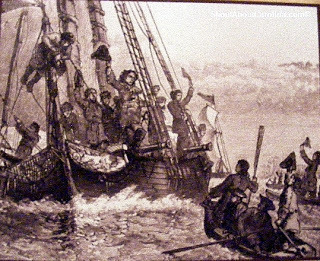 Blackbeard's head posted: Photo: http://shoutaboutcarolina.com/index.php/2010/08/most-famous-pirates-ships-legends-historic-photos/ Why mercury? Well it was thought of as a cure for a disease that pirates (indeed most sailors) were riddled with: syphilis. Blackbeard was probably suffering from this sexually transmitted disease – all the more awful, then, to learn that later that year (1718) he decided to "settle down" in North Carolina at Bath Town and marry the daughter of a wealthy merchant. Only his idea of 'settling' was to outwardly make it seem that he was an honest man, while secretly plundering every merchant ship that hailed within site of the Ocracoke and Pamlico River, claiming the cargo for himself and splitting the profits with the Governor of North Carolina. And the girl he married, Mary Ormond? She was his fourteenth wife, was sixteen years of age, and on their wedding night he forced her to prostitute herself with his crew. Gang rape, we would call it now.
Blackbeard's head posted: Photo: http://shoutaboutcarolina.com/index.php/2010/08/most-famous-pirates-ships-legends-historic-photos/ Why mercury? Well it was thought of as a cure for a disease that pirates (indeed most sailors) were riddled with: syphilis. Blackbeard was probably suffering from this sexually transmitted disease – all the more awful, then, to learn that later that year (1718) he decided to "settle down" in North Carolina at Bath Town and marry the daughter of a wealthy merchant. Only his idea of 'settling' was to outwardly make it seem that he was an honest man, while secretly plundering every merchant ship that hailed within site of the Ocracoke and Pamlico River, claiming the cargo for himself and splitting the profits with the Governor of North Carolina. And the girl he married, Mary Ormond? She was his fourteenth wife, was sixteen years of age, and on their wedding night he forced her to prostitute herself with his crew. Gang rape, we would call it now. 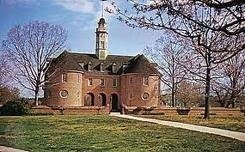 Colonial Williamsburg capitol
Colonial Williamsburg capitol
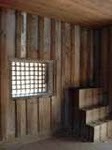 Williamsburg gaolBlackbeard being a menace to the Chesapeake and threatening the stability of the Virginia Tobacco Trade, Governor Spotswood decided to put an end to the foul Edward Teach. Technically, he was outside his jurisdiction, for North Carolina was not his domain, but he hired the use of two Royal Navy sloops and under the command of Lt. Maynard, sent them off to finish Blackbeard once and for all. We know the outcome of the desperate fight in the shallows of the Ocracoke because Maynard kept a meticulous logbook – and the records of the trials of the captured crew remain in Williamsburg to this day. Blackbeard was killed in the fight – although it took a lot to finish him off, while the captured crew were tried in the Capitol Building Court Room in Williamsburg and hanged.
Williamsburg gaolBlackbeard being a menace to the Chesapeake and threatening the stability of the Virginia Tobacco Trade, Governor Spotswood decided to put an end to the foul Edward Teach. Technically, he was outside his jurisdiction, for North Carolina was not his domain, but he hired the use of two Royal Navy sloops and under the command of Lt. Maynard, sent them off to finish Blackbeard once and for all. We know the outcome of the desperate fight in the shallows of the Ocracoke because Maynard kept a meticulous logbook – and the records of the trials of the captured crew remain in Williamsburg to this day. Blackbeard was killed in the fight – although it took a lot to finish him off, while the captured crew were tried in the Capitol Building Court Room in Williamsburg and hanged. So what has all this to do with my books?
Well, Bring It Close, the Third Voyage centres around those historical facts. Arrested for piracy after an indiscretion with an old flame, Jesamiah is held prisoner in Williamsburg's gaol. After his trial he is coerced into helping Spotswood make an end of Blackbeard – which suits Jesamiah because he, too, is keen to be rid of the man, who has threatened to kill him. Another worry – Jesamiah's beloved Tiola is in Bath Town, where Blackbeard resides.
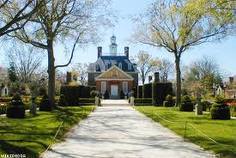 Governor's Palace by Alexander SpotswoodI have visited Williamsburg twice to research the facts behind the story – every bit of each scene set there is accurate, well apart from the involvement of Jesamiah! I investigated the gaol, the court room, the palace – and the route Jesamiah was taken on from Gaol to Palace.
Governor's Palace by Alexander SpotswoodI have visited Williamsburg twice to research the facts behind the story – every bit of each scene set there is accurate, well apart from the involvement of Jesamiah! I investigated the gaol, the court room, the palace – and the route Jesamiah was taken on from Gaol to Palace. By entwining the real facts of history with an imaginary story of Jesamiah's adventures – and blending in the supernatural storyline of the ghost of Jesamiah's father and Tiola's knowledge that Blackbeard has sold his soul to the devil, the result is, I hope, a cracking good adventure story.
And who is to say that it was not Jesamiah who planned that attack on Blackbeard? You will not find his name in Maynard's logbook, but then, Jesamiah made it quite plain that he did not want to be mentioned…
That's why I love writing this sort of fiction – who knows what is true, and what isn't?
You are welcome to visit my website , join me on Facebook , or come aboard the Sea Witch page .___________________ Thank you so much, Helen. What fun to discover details about what made our ancestors tick—and what made them ticked-off (could it be, um, pirates??). I hope our blog readers will take this opportunity to discover your books and enjoy the adventures of fiction—and the real-life people who went before us. To find and purchase Helen Hollick's books or e-books, visit her website, www.helenhollick.net.
Now, about that book giveaway contest: Helen is running a competition for fans of her Sea Witch Facebook page to win a copy of one of her books (all new "likes" welcome), but I have been told where this particular treasure trove of the competition page is located! If you decide to enter, Good Luck! Here it is: http://helen-myguests.blogspot.com/p/competition-page.html.Please note the expiration date of the contest, though this article will stay up far longer.
Published on July 05, 2011 00:00
July 1, 2011
Tomb effigies
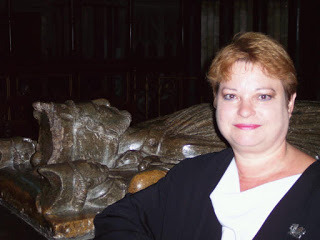 King John's tomb effigy in Worcester Cathedral, England, with Christy in 2004 Church Monumentsby George Herbert
King John's tomb effigy in Worcester Cathedral, England, with Christy in 2004 Church Monumentsby George Herbert While that my soul repairs to her devotion,
Here I intomb my flesh, that it betimes
May take acquaintance of this heap of dust;
To which the blast of death's incessant motion,
Fed with the exhalation of our crimes,
Drives all at last. Therefore I gladly trust
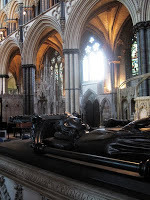 Visceral tomb of Eleanor of Castile, Lincoln CathedralMy body to this school, that it may learn
Visceral tomb of Eleanor of Castile, Lincoln CathedralMy body to this school, that it may learn To spell his elements, and find his birth
Written in dusty heraldry and lines;
Which dissolution sure doth best discern,
Comparing dust with dust, and earth with earth.
These laugh at jet and marble put for signs,
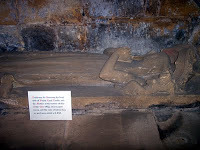 Euphemia de Clavering, 1269-1329, mother of Sir Ralph Neville II (1291-1367)To sever the good fellowship of dust,
Euphemia de Clavering, 1269-1329, mother of Sir Ralph Neville II (1291-1367)To sever the good fellowship of dust,And spoil the meeting. What shall point out them,
When they shall bow, and kneel, and fall down flat
To kiss those heaps, which now they have in trust?
Dear flesh, while I do pray, learn here thy stem
And true descent, that when thou shalt grow fat
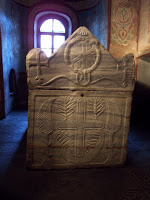 Tomb of Yaroslav the Wise, Prince of Novgorod and Kiev, in St. Sophia Cathedral at KievAnd wanton in thy cravings, thou mayst know
Tomb of Yaroslav the Wise, Prince of Novgorod and Kiev, in St. Sophia Cathedral at KievAnd wanton in thy cravings, thou mayst knowThat flesh is but the glass which holds the dust
That measures all our time; which also shall
Be crumbled into dust. Mark, here below
How tame these ashes are, how free from lust,That thou mayst fit thyself against thy fall.
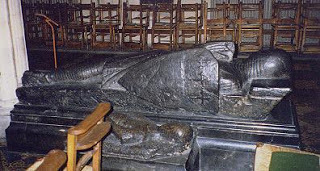 Effigy of Richard "Strongbow" de Clare, Dublin Ireland
Effigy of Richard "Strongbow" de Clare, Dublin Ireland
Published on July 01, 2011 00:01
June 15, 2011
The Little Ice Age, 1300-1800
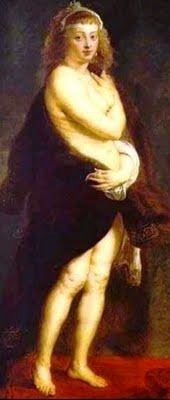 The Fur Cloak, by Rubens, about 1636-1639. Is history repeating itself? (Again?) Is there global cooling in our future? Scientists are predicting a period of less solar activity. See Associated Press article following.
The Fur Cloak, by Rubens, about 1636-1639. Is history repeating itself? (Again?) Is there global cooling in our future? Scientists are predicting a period of less solar activity. See Associated Press article following. Our ancestors survived conditions with considerably less resources than we have available. There was no central heating in their homes and shops, of course, and fuel (peat, coal, and wood) was just as expensive, or more so, as the fuels we consume today. Most people just couldn't afford the luxury of warmth in winter. They didn't change clothes or bathe much, especially in cold weather when they'd have to haul and heat water. They shared beds near a kitchen hearth, too. We who need our personal space would never survive that lifestyle!
This is just my observation from studying genealogy, not backed up with statistics, but it looks like family size burgeoned during the global temperature dip of the 16th and 17th centuries: maybe the long, freezing nights were not all that boring! Certainly, a number of family members of William and Mary Barrett Dyer had birthdays in September through December. So what really happened during the deep freezes back in January, February, and March?
The Little Ice Age, from about 1317-1800, began with catastrophic floods, crop failure, and domestic animal deaths (which brought on economic depression), harsh winters—and starvation. Epidemics raged unchecked, and millions died in the bubonic plague outbreak in 1348-1350. Because so many laborers (peasants tied to the land, who owed service to their landlords) died, cathedral and castle building ground to a halt for years.
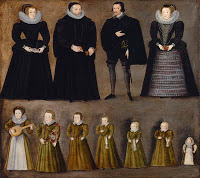 The extended Bartholomew family of Burley, early 1600s, with their seven surviving children. Two sons emigrated to colonial Massachusetts. The family are not among my ancestors.
The extended Bartholomew family of Burley, early 1600s, with their seven surviving children. Two sons emigrated to colonial Massachusetts. The family are not among my ancestors.Of course our ancestors knew nothing about it, but they experienced the effects of a plunge in sunspot activity in the 1600s, which corresponded with the coldest years of the Little Ice Age. Specifically during Mary Dyer's lifetime, 1611-1660, there was the time of famines, waves of bubonic plague across Europe, the Thirty Years War, the Great Migration to America, the English Civil War, and the explosion of African slave trade to the Americas and Europe.
Iceland's ports were ice-bound by miles for several years, and trade and passenger shipping from Europe was forced far south to avoid sea ice. Boston Harbor (sea water) froze over for two to three miles out, hard enough to walk on, for two weeks at a time.
Journal of Governor John Winthrop—January 1638: "About thirty persons of Boston going out in a fair day to Spectacle Island to cut wood, (the town being in great want thereof,) the next night the wind rose so high at N.E. with snow, and after at N.W. for two days, and then it froze so hard, as the bay was all frozen up, save a little channel. In this twelve of them gate to the Governor's Garden [an island], and seven more were carried in the ice in a small skiff out at Broad Sound, and kept among Brewster's Rocks, without food or fire, two days, and then the wind forbearing, they gate to Pullin Point, to a little house there of Mr. Aspenwall's. Three of them got home the next day over the ice, but their hands and feet frozen. Some lost their fingers and toes, and one died. The rest went from Spectacle Island to the main, but two of them fell into the ice, yet recovered again. In this extremity of weather, a small pinnace was cast away upon Long Island [in Boston Harbor] by Natascott, but the men were saved and came home upon the ice."
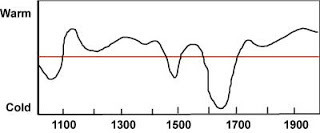 The Little Ice Age "peaked" in Mary Barrett Dyer's lifetime—the coldest years in many centuries were those she spent in colonial America. This graph shows the severity of winters in Europe and North America from 1000-2000 AD. The absolute coldest period, 1600-1675, coincides with William and Mary Dyer's life spans.
The Little Ice Age "peaked" in Mary Barrett Dyer's lifetime—the coldest years in many centuries were those she spent in colonial America. This graph shows the severity of winters in Europe and North America from 1000-2000 AD. The absolute coldest period, 1600-1675, coincides with William and Mary Dyer's life spans. More on the Dyers: Mary Dyer and freedom of conscience: http://bit.ly/kuTf4KArticle on Mary Dyer's individualism against orthodoxy and the established church: http://bit.ly/ivWJbO For a timeline on William and Mary Dyer's life together, see my post here. To learn more about the Dyers' life, join her Facebook friends.
The Dyers lived in Boston from 1635 to the spring of 1638, then co-founded Portsmouth, Rhode Island, about 60 miles away. One year later, they co-founded the city of Newport, Rhode Island, where they developed a large farm and the seaport.
When Mary Dyer was making a winter trip back to America after several years in England, her ship diverted to Barbados because of severe storms. From a letter written in Barbados on Feb 25, 1657: "A ship came in hither, which was going to New England, but the storms were so violent that they were forced to come hither, [until] the winter there was nearly over. In this ship were two Friends, Anne Burden of Bristol, and one Mary Dyer from London; both lived in New England formerly, and were members cast out of their [Puritan] churches. Mary goes to her husband who lives upon Rhode Island..."
A NASA website says, "During the coldest part of the Little Ice Age, from 1645 to 1715, there is believed to have been a decrease in the total energy output from the Sun, as indicated by little or no sunspot activity. Known as the Maunder Minimum, astronomers of the time observed only about 50 sunspots for a 30-year period as opposed to a more typical 40-50,000 spots. The Sun normally shows signs of variability, such as its eleven-year sunspot cycle. Within that time, it goes from a minimum to a maximum period of activity represented by a peak in sunspots and flare activity."
More from NASA: "Between the mid-1600s and the early 1700s the Earth's surface temperatures in the Northern Hemisphere appear to have been at or near their lowest values of the last millennium. European winter temperatures over that time period were reduced by 1.8 to 2.7 degrees Fahrenheit (1-1.5 Celsius). This cool down is evident through derived temperature readings from tree rings and ice cores, and in historical temperature records, as gathered by the University of Massachusetts-Amherst and the University of Virginia."
http://media2.abc15.com//photo/2011/06/15/sun_20110615082730_320_240.JPG
 A Solar and Heliospheric Observatory image shows Region 486 that unleashed a record flare (lower left) November 18, 2003 on the sun. The spot itself cannot yet be seen but large, hot, gas-filled loops above this region are visible.
A Solar and Heliospheric Observatory image shows Region 486 that unleashed a record flare (lower left) November 18, 2003 on the sun. The spot itself cannot yet be seen but large, hot, gas-filled loops above this region are visible. Photographer: Getty Images. Goodnight sun: Scientists predict sunspots might disappear for yearsBy: Associated PressUpdate as of June 15, 2011
WASHINGTON - The sun is heading into an unusual and extended hibernation, scientists predict. Around 2020, sunspots may disappear for years, maybe decades.
But scientists say it is nothing to worry about. Solar storm activity has little to do with life-giving light and warmth from the sun. The effects from a calmer sun are mostly good.
There'd be fewer disruptions of satellites and power systems. And it might mean a little less increase in global warming. It's happened before, but not for a couple centuries.
"The solar cycle is maybe going into hiatus, sort of like a summertime TV show," said National Solar Observatory associate director Frank Hill, the lead author of a scientific presentation at a solar physics conference in New Mexico.
Scientists don't know why the sun is going quiet. But all the signs are there. Hill and colleagues based their prediction on three changes in the sun spotted by scientific teams: Weakening sunspots, fewer streams spewing from the poles of the sun's corona and a disappearing solar jet stream.
Those three cues show, "there's a good possibility that the sun could be going into some sort of state from which it takes a long time to recover," said Richard Altrock, an astrophysicist at the Air Force Research Laboratory and study co-author.
The prediction is specifically aimed at the solar cycle starting in 2020. Experts say the sun has already been unusually quiet for about four years with few sunspots -- higher magnetic areas that appear as dark spots.
The enormous magnetic field of the sun dictates the solar cycle, which includes sunspots, solar wind and ejection of fast-moving particles that sometimes hit Earth. Every 22 years, the sun's magnetic field switches north and south, creating an 11-year sunspot cycle. At peak times, like 2001, there are sunspots every day and more frequent solar flares and storms that could disrupt satellites.
Earlier this month, David Hathaway, NASA's top solar storm scientist, predicted that the current cycle, which started around 2009, will be the weakest in a century. Hathaway is not part of Tuesday's [June 14, 2011] prediction.
Altrock also thinks the current cycle won't have much solar activity. He tracks streamers from the solar corona, the sun's outer atmosphere seen during eclipses. The streamers normally get busy around the sun's poles a few years before peak solar storm activity. That "rush to the poles" would have happened by now, but it hasn't and there's no sign of it yet. That also means the cycle after that is uncertain, he said.
Matt Penn of the National Solar Observatory, another study co-author, said sunspot magnetic fields have been steadily decreasing in strength since 1998. If they continue on the current pace, their magnetic fields will be too weak to become spots as of 2022 or so, he said.
Jet streams on the sun's surface and below are also early indicators of solar storm activity, and they haven't formed yet for the 2020 cycle. That indicates that there will be little or delayed activity in that cycle, said Hill, who tracks jet streams.
"People shouldn't be scared of this," said David McComas, a scientist at the Southwest Research Institute in San Antonio, who wasn't part of the team. "This is about the magnetic field and the ionized gas coming out of the sun. It's a reduction in that, not the light and the heat."
So sunspot reduction is to blame?There are questions about what this means for Earth's climate. Three times in the past the regular 11-year solar cycle has gone on an extended vacation -- at the same time as cool periods on Earth.
OK, maybe notSkeptics of man-made global warming from the burning of fossil fuels have often pointed to solar radiation as a possible cause of a warming Earth, but they are in the minority among scientists. The Earth has warmed as solar activity has decreased.
Andrew Weaver, a climate scientist at the University of Victoria, said there could be small temperature effects, but they are far weaker than the strength of man-made global warming from carbon dioxide and methane. He noted that in 2010, when solar activity was mostly absent, Earth tied for its hottest year in more than a century of record-keeping.
Hill and colleagues wouldn't discuss the effects of a quiet sun on temperature or global warming.
"If our predictions are true, we'll have a wonderful experiment that will determine whether the sun has any effect on global warming," Hill said.
Published on June 15, 2011 22:46
June 1, 2011
Mary Dyer and freedom of conscience
"It is not the glorious battlements, the painted windows, the crouching gargoyles that support a building, but the stones that lie unseen in or upon the earth. It is often those who are despised and trampled on that bear up the weight of a whole nation." ~John Owen, English Puritan minister, 1616–1683.
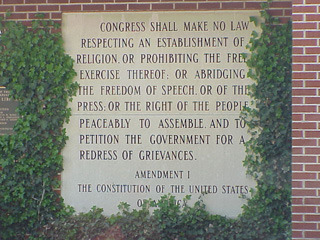 June 1, 1660 was a landmark date in American history. Its relation to civil rights guaranteed by the US Constitution's Bill of Rights should be noted, specifically the 1st Amendment regarding freedom of religion (to worship or not, as your own conscience dictates), and freedom of speech and assembly.
June 1, 1660 was a landmark date in American history. Its relation to civil rights guaranteed by the US Constitution's Bill of Rights should be noted, specifically the 1st Amendment regarding freedom of religion (to worship or not, as your own conscience dictates), and freedom of speech and assembly. Mary Barrett Dyer, hanged in Boston on June 1, 1660, was martyred for liberty of conscience that Americans enjoy under the Constitution's Bill of Rights. Other countries have modeled their constitutions and rights on those of the United States, so these liberties have become global.
In 2010, on the 350th anniversary of Mary Dyer's martyrdom, there was no mention of her in newspapers or online. No events in Boston, Rhode Island, or Washington, DC. No political or religious movements made mention of the sacrifice of the only female religious martyr in America.
Torture and persecutionIn the late 1650s, Quakers had been persecuted for their nonconformism by having their tongues bored with a hot awl; men and women were stripped bare to the waist and flogged with up to 30 strokes of the thrice-knotted lash, to add more injury to each stroke; they had their ears either nailed to a post, or sliced off altogether; without a trial, they were thrown in earthen-floored jail cells, sometimes for months, with no candle or heat in New England's harsh winters; prisoners were beaten several times a week. Even non-Quakers whose consciences were pricked by this harsh treatment were jailed, whipped, heavily fined, and disfranchised (lost their civil rights and vote) for harboring or sympathizing publicly with Quakers.
Contrary to popular opinion in genealogy sites, Mary Barrett Dyer wasn't hanged "for the crime of being a Quaker." It wasn't a crime to be a Quaker! However, they didn't attend Puritan worship or teaching services or pay required tithes, didn't keep the Sabbath holy, and criticized the government leaders for their cruelty. Mary Dyer provoked her own trials and execution for what we'd call civil disobedience, by repeatedly defying the totalitarian Puritan regime headed by Massachusetts Governor John Endecott. The Massachusetts Bay founders believed that religious error or dissent from their dogma was treasonable.
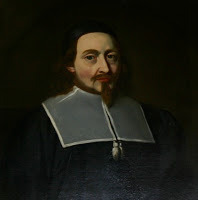 Endecott, a religious zealot, had a checkered past, leaving an illegitimate son in England before he emigrated to Salem, Massachusetts in 1629; treasonably cutting the "idolatrous" cross from the British flag; a Massachusetts committee reported in 1634 "that they apprehend [Endecott] had offended therein many ways, in rashness, uncharitableness, indiscretion and exceeding the limits of his calling;" acting in ways that endangered the patent that was their title to land in New England; creating a mint in Boston that made unauthorized—and therefore counterfeit—coins with a 1652 imprint for 30 years (so if the English government confiscated the minting, Boston could claim the coins were all from 1652 when they had little oversight during the English political upheaval); and punishing his indentured servant girl with 32 lash-stripes and public humiliation for fornication, bearing a child out of wedlock, and insistently naming his son as the predatory father (which, of course, would make John Endecott the father of a rapist and grandfather of a lowly servant's bastard—can't have that!).
Endecott, a religious zealot, had a checkered past, leaving an illegitimate son in England before he emigrated to Salem, Massachusetts in 1629; treasonably cutting the "idolatrous" cross from the British flag; a Massachusetts committee reported in 1634 "that they apprehend [Endecott] had offended therein many ways, in rashness, uncharitableness, indiscretion and exceeding the limits of his calling;" acting in ways that endangered the patent that was their title to land in New England; creating a mint in Boston that made unauthorized—and therefore counterfeit—coins with a 1652 imprint for 30 years (so if the English government confiscated the minting, Boston could claim the coins were all from 1652 when they had little oversight during the English political upheaval); and punishing his indentured servant girl with 32 lash-stripes and public humiliation for fornication, bearing a child out of wedlock, and insistently naming his son as the predatory father (which, of course, would make John Endecott the father of a rapist and grandfather of a lowly servant's bastard—can't have that!). 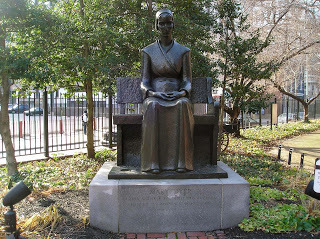 The colony and later state of Rhode Island was founded by Roger Williams in the 1630s as a haven for freedom of conscience, and that's where Mary and her husband and children made their home after being ejected from Massachusetts in 1637 over a religious matter prosecuted by the church state. Mary studied Quaker beliefs in England for several years, and returned to Boston only to be thrown into jail for 10 weeks with no notice to her husband in nearby Rhode Island.
The colony and later state of Rhode Island was founded by Roger Williams in the 1630s as a haven for freedom of conscience, and that's where Mary and her husband and children made their home after being ejected from Massachusetts in 1637 over a religious matter prosecuted by the church state. Mary studied Quaker beliefs in England for several years, and returned to Boston only to be thrown into jail for 10 weeks with no notice to her husband in nearby Rhode Island. Though Mary could have lived out her life in safety, she believed she was called by God to try the bloody religious laws of Connecticut and Massachusetts, and she boldly entered their territory to both preach, and support her Friends in the faith by visiting them in prison.
Prepared to dieHer letters written from Boston prison to Governor Endecott, her actions, and her statements at trial demonstrate to us that she willingly sacrificed her life to stop the torture and persecution of people who were obeying the voice of God in their hearts. She wrote, "Be not found Fighters against God, but let my Counsel and Request be accepted with you, To repeal all such Laws, that the Truth and Servants of the Lord, may have free Passage among you and you be kept from shedding innocent Blood…My life is not accepted, neither availeth me, in Comparison of the Lives and Liberty of the Truth and Servants of the Living God… yet nevertheless, with wicked Hands have you put two of them to Death, which makes me to feel, that the Mercies of the Wicked is Cruelty. I rather choose to die than to live, as from you, as Guilty of their innocent Blood… Therefore I leave these Lines with you, appealing to the faithful and true Witness of God, which is One in all Consciences, before whom we must all appear; with whom I shall eternally rest, in Everlasting Joy and Peace, whether you will hear or forebear: With him is my Reward, with whom to live is my Joy, and to die is my Gain."
Knowing that there was a death sentence hanging over her, she deliberately avoided her husband who would have stopped her, and returned to Boston, where she was arrested and jailed. She was convicted and condemned on May 31, 1660, and was hanged the next day, on June 1.
The shock over Mary Dyer's death crossed the Atlantic immediately, and King Charles II put an end to the New England death penalty for religious practice, requiring that capital cases be tried in England. Public outrage in New England over Mary's death actually consolidated sympathy for Quakers, Baptists, Jews, and others who refused to conform to Puritanism. Even some of the New England Puritans demonstrated their opposition to the harsh treatment of people of conscience, and suffered imprisonment, banishment, confiscation of property, and heavy fines. A number of those who'd suffered persecution converted to the Quaker faith. Gradually, the torture and persecution slowed.
William Dyer's name appears on the 1663 royal charter granting rights of freedom of religion to Rhode Island colony. He and several others had worked closely with Dr. John Clarke of Newport, the architect of the document, to preserve the separation of church and state, and promote the freedom of conscience. One hundred thirty years later, the concept became concrete in the US Constitution's Bill of Rights, Amendment I.
Article on Mary Dyer's individualism against orthodoxy and the established church: http://rootingforancestors.blogspot.com/#ixzz1O67URZcQ For a timeline on William and Mary Dyer's life together, see my post here. To learn more about the Dyers' life, join her Facebook friends.
Published on June 01, 2011 23:58
May 30, 2011
Memorial to military ancestors
Considering that practically every medieval male ancestor of name was a knight, baron, earl, prince, or king, it was inevitable that they'd be military-minded. Below are a few representatives of hundreds of warrior ancestors! Also, I've included a few more-recent pictures of direct ancestors. Their captions explain their names and roles in making history.
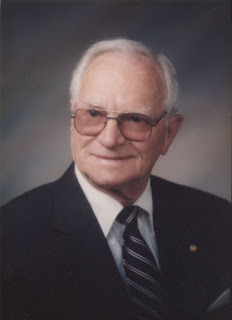 Andrew Anson, 1913-1999, my maternal grandfather. US Navy, WW II, Pacific theater.
Andrew Anson, 1913-1999, my maternal grandfather. US Navy, WW II, Pacific theater.
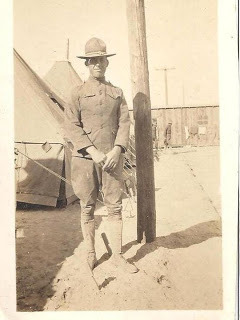 Leonard Robinson, 1886-1975, paternal grandfather, US Army, WW I in France.
Leonard Robinson, 1886-1975, paternal grandfather, US Army, WW I in France.
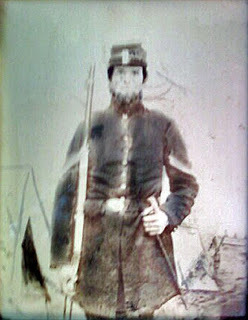 George Washington Stewart Anson, maternal great-great-grandfather, 1830-1891, Union Army, United States Civil War.
George Washington Stewart Anson, maternal great-great-grandfather, 1830-1891, Union Army, United States Civil War.
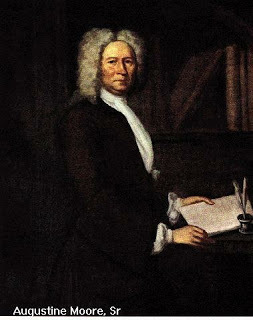 Colonel Augustine Moore, Sr., 7x grandfather, ~1685-1743. Born Yorkshire, died Chelsea Plantation, Virginia.
Colonel Augustine Moore, Sr., 7x grandfather, ~1685-1743. Born Yorkshire, died Chelsea Plantation, Virginia.
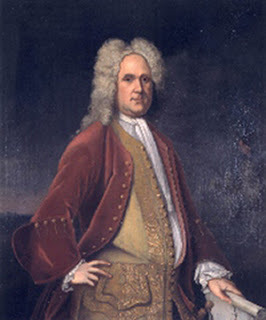 My 9x-grandfather, Lieutenant Colonel Alexander Spottswood, 1676-1740, royally-appointed Governor of Virginia 1710-1722. Spotsylvania County is named after this man. He commissioned the capture and execution of Blackbeard the Pirate, Edward Teach. His father, Dr. Robert Spottswood, was the surgeon to the British military post in Tangiers; his grandfather Sir Robert Spottswood, a royalist, was executed by Parliamentarians after his capture at the Battle of Philipaugh in England's Civil War; and his great-grandfather John Spottiswoode was the Archbishop of Scotland.
My 9x-grandfather, Lieutenant Colonel Alexander Spottswood, 1676-1740, royally-appointed Governor of Virginia 1710-1722. Spotsylvania County is named after this man. He commissioned the capture and execution of Blackbeard the Pirate, Edward Teach. His father, Dr. Robert Spottswood, was the surgeon to the British military post in Tangiers; his grandfather Sir Robert Spottswood, a royalist, was executed by Parliamentarians after his capture at the Battle of Philipaugh in England's Civil War; and his great-grandfather John Spottiswoode was the Archbishop of Scotland.
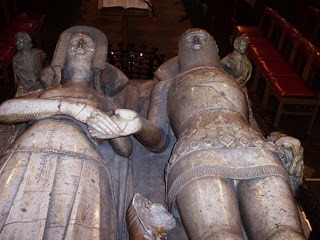 Photo by Christy K. Robinson Catherine Mortimer, Countess, and her husband Thomas Beauchamp, 1314-1369, 3rd Earl of Warwick, Knight of the Garter. Thomas died at Calais of either typhoid fever, or from being poisoned by Humphrey de Bohun VII (not my ancestor--probably an uncle or cousin).
Photo by Christy K. Robinson Catherine Mortimer, Countess, and her husband Thomas Beauchamp, 1314-1369, 3rd Earl of Warwick, Knight of the Garter. Thomas died at Calais of either typhoid fever, or from being poisoned by Humphrey de Bohun VII (not my ancestor--probably an uncle or cousin).
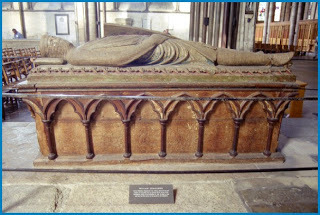 Photo by Christy K. Robinson William Longespee "Longsword," 1176-1226. Earl of Salisbury, illegitimate son of Henry II, Duke of Anjou and Normandy, and King of England, and Ida de Tosny (mistress of Henry II, later wife of Roger Bigod, 2nd Earl of Norfolk). William Longespee's ancestor through great-grandmother Sybil de Chaworth and his father King Henry II, was William I "Longespee" of Normandy, 2nd Duke of Normandy, ~900-942. William's tomb is at Salisbury Cathedral in the center aisle of the nave.
Photo by Christy K. Robinson William Longespee "Longsword," 1176-1226. Earl of Salisbury, illegitimate son of Henry II, Duke of Anjou and Normandy, and King of England, and Ida de Tosny (mistress of Henry II, later wife of Roger Bigod, 2nd Earl of Norfolk). William Longespee's ancestor through great-grandmother Sybil de Chaworth and his father King Henry II, was William I "Longespee" of Normandy, 2nd Duke of Normandy, ~900-942. William's tomb is at Salisbury Cathedral in the center aisle of the nave.
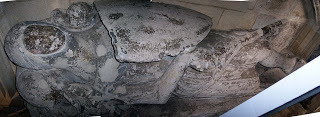 Photo by Christy K. Robinson Humphrey de Bohun (VIII of that name), Earl of Hereford and Essex, 1276-1322. "[The 4th Earl of] Hereford led the fight on the bridge [Boroughbridge], but he and his men were caught in the arrow fire. Then one of de Harclay's pikemen, concealed beneath the bridge, thrust upwards between the planks and skewered the Earl of Hereford through the anus, twisting the head of the iron pike into his intestines. His dying screams turned the advance into a panic." Humphrey de Bohun's effigy (and probably remains) are at Exeter Cathedral in the South Choir aisle.
Photo by Christy K. Robinson Humphrey de Bohun (VIII of that name), Earl of Hereford and Essex, 1276-1322. "[The 4th Earl of] Hereford led the fight on the bridge [Boroughbridge], but he and his men were caught in the arrow fire. Then one of de Harclay's pikemen, concealed beneath the bridge, thrust upwards between the planks and skewered the Earl of Hereford through the anus, twisting the head of the iron pike into his intestines. His dying screams turned the advance into a panic." Humphrey de Bohun's effigy (and probably remains) are at Exeter Cathedral in the South Choir aisle.
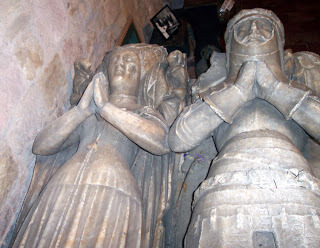 Photo by Christy K. RobinsonMargaret Peverel and husband Robert de Ferrers, 2nd Earl of Derby, 1100~1159. He founded Merevale Abbey in Warwickshire during the civil war between Empress Matilda and King Stephen. The effigies are in the gatehouse chapel of that abbey.
Photo by Christy K. RobinsonMargaret Peverel and husband Robert de Ferrers, 2nd Earl of Derby, 1100~1159. He founded Merevale Abbey in Warwickshire during the civil war between Empress Matilda and King Stephen. The effigies are in the gatehouse chapel of that abbey.

 Andrew Anson, 1913-1999, my maternal grandfather. US Navy, WW II, Pacific theater.
Andrew Anson, 1913-1999, my maternal grandfather. US Navy, WW II, Pacific theater.
 Leonard Robinson, 1886-1975, paternal grandfather, US Army, WW I in France.
Leonard Robinson, 1886-1975, paternal grandfather, US Army, WW I in France.  George Washington Stewart Anson, maternal great-great-grandfather, 1830-1891, Union Army, United States Civil War.
George Washington Stewart Anson, maternal great-great-grandfather, 1830-1891, Union Army, United States Civil War.  Colonel Augustine Moore, Sr., 7x grandfather, ~1685-1743. Born Yorkshire, died Chelsea Plantation, Virginia.
Colonel Augustine Moore, Sr., 7x grandfather, ~1685-1743. Born Yorkshire, died Chelsea Plantation, Virginia.  My 9x-grandfather, Lieutenant Colonel Alexander Spottswood, 1676-1740, royally-appointed Governor of Virginia 1710-1722. Spotsylvania County is named after this man. He commissioned the capture and execution of Blackbeard the Pirate, Edward Teach. His father, Dr. Robert Spottswood, was the surgeon to the British military post in Tangiers; his grandfather Sir Robert Spottswood, a royalist, was executed by Parliamentarians after his capture at the Battle of Philipaugh in England's Civil War; and his great-grandfather John Spottiswoode was the Archbishop of Scotland.
My 9x-grandfather, Lieutenant Colonel Alexander Spottswood, 1676-1740, royally-appointed Governor of Virginia 1710-1722. Spotsylvania County is named after this man. He commissioned the capture and execution of Blackbeard the Pirate, Edward Teach. His father, Dr. Robert Spottswood, was the surgeon to the British military post in Tangiers; his grandfather Sir Robert Spottswood, a royalist, was executed by Parliamentarians after his capture at the Battle of Philipaugh in England's Civil War; and his great-grandfather John Spottiswoode was the Archbishop of Scotland.
 Photo by Christy K. Robinson Catherine Mortimer, Countess, and her husband Thomas Beauchamp, 1314-1369, 3rd Earl of Warwick, Knight of the Garter. Thomas died at Calais of either typhoid fever, or from being poisoned by Humphrey de Bohun VII (not my ancestor--probably an uncle or cousin).
Photo by Christy K. Robinson Catherine Mortimer, Countess, and her husband Thomas Beauchamp, 1314-1369, 3rd Earl of Warwick, Knight of the Garter. Thomas died at Calais of either typhoid fever, or from being poisoned by Humphrey de Bohun VII (not my ancestor--probably an uncle or cousin).  Photo by Christy K. Robinson William Longespee "Longsword," 1176-1226. Earl of Salisbury, illegitimate son of Henry II, Duke of Anjou and Normandy, and King of England, and Ida de Tosny (mistress of Henry II, later wife of Roger Bigod, 2nd Earl of Norfolk). William Longespee's ancestor through great-grandmother Sybil de Chaworth and his father King Henry II, was William I "Longespee" of Normandy, 2nd Duke of Normandy, ~900-942. William's tomb is at Salisbury Cathedral in the center aisle of the nave.
Photo by Christy K. Robinson William Longespee "Longsword," 1176-1226. Earl of Salisbury, illegitimate son of Henry II, Duke of Anjou and Normandy, and King of England, and Ida de Tosny (mistress of Henry II, later wife of Roger Bigod, 2nd Earl of Norfolk). William Longespee's ancestor through great-grandmother Sybil de Chaworth and his father King Henry II, was William I "Longespee" of Normandy, 2nd Duke of Normandy, ~900-942. William's tomb is at Salisbury Cathedral in the center aisle of the nave.
 Photo by Christy K. Robinson Humphrey de Bohun (VIII of that name), Earl of Hereford and Essex, 1276-1322. "[The 4th Earl of] Hereford led the fight on the bridge [Boroughbridge], but he and his men were caught in the arrow fire. Then one of de Harclay's pikemen, concealed beneath the bridge, thrust upwards between the planks and skewered the Earl of Hereford through the anus, twisting the head of the iron pike into his intestines. His dying screams turned the advance into a panic." Humphrey de Bohun's effigy (and probably remains) are at Exeter Cathedral in the South Choir aisle.
Photo by Christy K. Robinson Humphrey de Bohun (VIII of that name), Earl of Hereford and Essex, 1276-1322. "[The 4th Earl of] Hereford led the fight on the bridge [Boroughbridge], but he and his men were caught in the arrow fire. Then one of de Harclay's pikemen, concealed beneath the bridge, thrust upwards between the planks and skewered the Earl of Hereford through the anus, twisting the head of the iron pike into his intestines. His dying screams turned the advance into a panic." Humphrey de Bohun's effigy (and probably remains) are at Exeter Cathedral in the South Choir aisle.
 Photo by Christy K. RobinsonMargaret Peverel and husband Robert de Ferrers, 2nd Earl of Derby, 1100~1159. He founded Merevale Abbey in Warwickshire during the civil war between Empress Matilda and King Stephen. The effigies are in the gatehouse chapel of that abbey.
Photo by Christy K. RobinsonMargaret Peverel and husband Robert de Ferrers, 2nd Earl of Derby, 1100~1159. He founded Merevale Abbey in Warwickshire during the civil war between Empress Matilda and King Stephen. The effigies are in the gatehouse chapel of that abbey.
Published on May 30, 2011 15:04
April 17, 2011
John Marshal's iron anvil, a guest post by Elizabeth Chadwick
Today, my blog has been elevated from blogosphere to stratosphere by the literary contribution of one of my absolutely-favorite authors, Elizabeth Chadwick. She supplied several of the photos, too. The bold and highlighted names in the article are those of my ancestors—and probably yours, or you wouldn't have found this article in a search!
John FitzGilbert Marshal is 32 generations removed from me. The Marshal clan married to the families of, and were "in-laws" of de Clare, Llewellyn Prince of Wales, John King of England, Quincy, Bigod, Tosny, Ferrers, de Braose, de Bohun, Salisbury, Gloucester, FitzWalter, Mortimer, de Lacy, Percy, Neville—to name a few. Take us back to the twelfth century, please, Elizabeth!
John FitzGilbert Marshal's iron anvil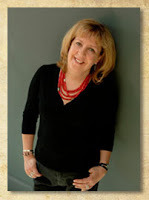 Guest author Elizabeth Chadwick
Guest post by Elizabeth Chadwick
Guest author Elizabeth Chadwick
Guest post by Elizabeth Chadwick
Many thanks to Christy for inviting me along to talk on her blog.
I want to tell you about a mediaeval nobleman called John Marshal. His fourth son, William, is justly famous among medievalists and those in the know, for being the greatest knight of the Middle Ages and with a reputation that still resonates today.
John Marshal's reputation has considerably less burnish than his illustrious son's and has suffered at the hands of modern novelists and due to a mindset among modern readers that frequently does not allow for the rules and realities of life in the difficult mid-12th century. To understand John Marshal, his deeds, dilemmas, and decisions, one needs to view him through the lens of that period, and only then does the living, breathing man emerge with energetic clarity.
Professor David Crouch, historian and senior authority on the Marshals in the academic community, says of John Marshal:
John FitzGilbert Marshal was probably born in the southwest of England, most likely Wiltshire or Berkshire around the year 1105. His father was a Marshal at the court of King Henry I and we know his name was Gilbert Giffard. The appellation is a fairly common Norman one, meaning 'chubby cheeks.' John's younger brother William, entered holy orders and had the living of the church of Cheddar in Somerset. He went on to become chancellor to the Empress Matilda. If there were other siblings they have not come down to us in history. We also don't know the name of John Marshal's mother, although some genealogy sites suggest that she was a de Venoix and perhaps called Heloise. Venoix is very close to Caen in the Calvados region of Normandy where many of William the Conqueror's followers came from. There was also a royal marshal called Robert de Venoix, so it can be speculated that the families by association of work, formed a closer bond through marriage. I must stress that John's maternal parentage is open to debate and not hard fact.
Gilbert the Marshal had estates provided for him to live off what he performed his duties at court. These included Tidworth in Wiltshire and Nettlecome in Somerset. The family had estates in Devon and possessed seven and a half knights' fees for scattered estates held for various landlords including the Dean of Glastonbury. Hamstead, now Hampstead Marshall in Berkshire, was also probably a holding. There is a 13th-century mention of the marshal's right to Hamstead and the Grange at Speen for services of the Marshal's Rod. Speen lies just outside Newbury on an area of strategically valuable high land overlooking the modern town.
The Marshal family were of minor nobility but ambitious to change that. There were middle-ranking royal civil servants on the make. The Marshal's duties were numerous, and since John followed his father into the position, he must have learned the ropes from an early age. The word Marshal comes from Marescallus, meaning 'Horse Slave,' and at one time they had been stable hands under the control of the Constable's department. Although the office rose from these humble beginnings, the marshal's work was much concerned with horses and transport and keeping order. The marshals had their own department at court and there were several of them although with a Master Marshal in charge of all. This was a somewhat fluid position when John was growing up and there was a certain amount of jockeying for position within the ranks.
The marshal's duties included seeing that the stables were properly run and supplied and providing harness and mounts for those in need of them. The job also involved dealing with the kennels and the mews. It was the marshal's task to provide carts for transport when the court was on the move. He had to find lodging for the household and keep order at the court. As a symbol of the latter office, he carried the Marshal's Rod – a kind of ceremonial stick or mace and still in evidence today with the title of 'Black Rod' and said mace being held by the officer in charge of the ushers of the Houses of Parliament. In the 12th century, the Marshal had to ensure that the 'verge' was observed. A verge was a personal space between the king and any supplicant. Take a step too far and the Marshal's rod would make sure you knew you had transgressed! The Marshal was in charge of the ushers who saw to it that only desirables got in to see the king. They were the club bouncers of their day so to speak. We know that two of John's ushers were called Gilbert Bonhomme and Ralf. Another aspect of the job was dealing with the 'ladies of the night' who serviced the court. The Marshal had to keep the working girls in line and regulate their activities. There were fines for unruly behaviour, and one suspects that this was an area where backhanders and insider dealing frequently went on.
The Marshal also had to sit at the exchequer. It was his task to take responsibility for anyone who couldn't pay their debts, and his department maintained the debtor's prison. Being in there would cost a sheriff or a bailiff half a mark for every night they were in custody. On top of this he kept the tallies of all the wages owed to the King's troops when in the field and saw that they were paid, for which he was entitled to a portion of that wage bill. Perks of the job included being entitled to every black and white horse taken on a battle campaign! Each time a noble's son was knighted at court, the marshal was entitled to a payment of a palfrey or a saddle. The Master Marshal's daily wage was two shillings and he was entitled to bread, wine and candles whilst working at court. There were also 'backhander' perks from barons higher up the food chain who thought that a bit of glad-handing in the form of grants of land was useful in order to keep the king's marshal sweet.
When John was in his mid-twenties, he and his father had to fight for their right to be the Master Marshals of the court. Two of the other Marshals, Robert de Venoix and William de Hastings were claiming the post, but John and his father were successful in their petition, which probably took the form of a trial by combat. John's father died around 1129 or 1130 and John inherited his position at court, although he had to pay 40 marks for the privilege. This included the office of 'avener' or provider of provender. To inherit his lands, he had to pay the death duty of £22 13s and 4d. Some time over the next few years, he married an heiress of modest worth with lands adjoining his own Wiltshire and Berkshire interests. She was called Aline Pipard and her main estate was at Clyffe Pypard in Wiltshire, not so far from John's own territories. It was a good solid match, although not a spectacular one.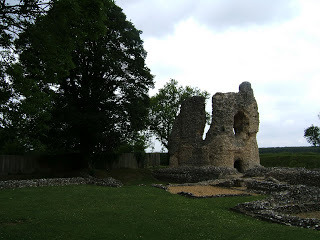 Ludgershall Castle, a holding of John Marshal's. Photo courtesy of E. Chadwick.
Ludgershall Castle, a holding of John Marshal's. Photo courtesy of E. Chadwick.
Aline bore John two sons – Walter and Gilbert. In 1135 King Henry I died and the country was thrown into turmoil as two claimants jostled for the crown – Henry's daughter Matilda, and her cousin, Stephen. Initially, John swore fealty to Stephen and was granted the castles of Ludgershall and the town and castle of Marlborough in Wiltshire in reward. Stephen's generosity gave John a strong power base and made him formidable in the Kennet Valley and northeast Wiltshire.
In 1139, the Empress Matilda came to England and made her bid to take the crown from Stephen. For whatever reason, Stephen suspected John Marshal of duplicity and besieged him at Marlborough. My personal opinion is that John had fallen foul of the factions at court who thought he had been receiving too many favours, and felt that he should be put in his place. He had no strong affinities at Stephen's court and a man isolated was a man who could be picked off and brought down. I think John jumped before he was pushed (off the mortal coil). Speculation aside, what is known is that John swore for the Empress and adhered to her cause for the rest of the Civil War. His brother William joined her entourage as her chancellor and remained with her until at least 1151. Unfortunately for John, the Empress's attempt to regain the throne was not plain sailing and to cut a long story short, she lost her advantage and while besieging the Bishop of Winchester at his palace of Wolvesely, she was almost captured. John was a few miles out of Winchester, dealing with a supply problem, when he heard that the troops of William D'Ypres, a Flemish mercenary in the pay of Stephen's queen, were coming down the Andover road straight for him. If D'Ypres managed to break through, John knew that Winchester would be encircled and the Empress captured. John made his stand at Wherwell where there was a ford over the river Teste beside a Benedictine nunnery that had been founded by an Anglo Saxon queen in the late 10th century.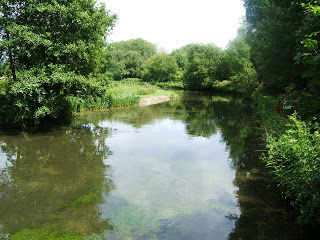 River Teste at Wherwell. Photo courtesy of E. Chadwick.
River Teste at Wherwell. Photo courtesy of E. Chadwick.
John fought for as long as he could, but with D'Ypres' numbers too great to withstand, he retreated into the nunnery and barricaded himself in. D'Ypres knew he couldn't leave a man like John Marshal to create mayhem in his rear, so he ordered the nunnery to be burned along with the men inside it. There was mayhem and chaos. Some of the troops fled the burning church only to meet their end on the edges of the mercenary's swords. John barricaded himself in the tower with another knight and refused to come out. When his companion feared for their lives and wanted to surrender, John told him that he would kill him with his own hands if he mentioned that word again. They stayed put, but John paid the price when molten lead from the church roof landed on his face and burned out his eye. Once D'Ypres' force had moved on, John staggered from the church with his companion, and the two of them made their way to safety. This must have been something of a feat because that safety was 25 miles away at Marlborough; they were on foot, and John had suffered a terrible facial injury.
Nevertheless, they made it and once recovered, John set out to recoup and regroup. Modern novelists and readers studying this detail sometimes dismiss John's actions as those of a lunatic adrenaline junkie, but I don't believe that is the case at all. Like a commander in World War II ordered to hold a particular bridge against the enemy in dire circumstances, he did so. He did his duty; he did what he had to do despite the terrible odds against him, and that to me is a man who knows what his word of honour is worth and what doing your duty really means.
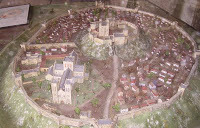 Model of Sarum/Salisbury in the 12th century.John's most powerful neighbour in the region was Walter of Salisbury, hereditary sheriff of Salisbury (nowadays called Old Sarum). Walter himself came from a paternal Anglo Saxon line that had survived the Norman Conquest. When Walter died, his son William succeeded him, but died not long after the battle of Wilton in 1143. The second son, Patrick, became lord of Salisbury and he supported Stephen. Looking to curtail his forceful neighbour in the Kennet valley, Patrick took up arms against John. John ably defended himself, although he had fewer resources than Patrick, and even if often on the back foot, it was never defeat. Eventually Robert Earl of Gloucester, the Empress's brother and chief general, stepped between the men. He offered Patrick an earldom if he would come over to the Empress and he suggested that John divorce his wife and marry Patrick's sister to make peace between them. The men agreed and sometime between 1144 and 1145, John Marshal annulled his marriage to Aline and took Sybilla FitzWalter to wife. Aline was remarried to Gloucester's uncle, a widower called Philip de Gay or de Gai. On the surface, John's action may seem harsh, but again, that's to judge him by the standards of our day, not the 12th century. By doing what he did, he turned a 'you will lose' situation into a 'you might win' one and stabilised life for himself and his dependents. Aline was not disparaged by her remarriage, and his sons retained their inheritance.
Model of Sarum/Salisbury in the 12th century.John's most powerful neighbour in the region was Walter of Salisbury, hereditary sheriff of Salisbury (nowadays called Old Sarum). Walter himself came from a paternal Anglo Saxon line that had survived the Norman Conquest. When Walter died, his son William succeeded him, but died not long after the battle of Wilton in 1143. The second son, Patrick, became lord of Salisbury and he supported Stephen. Looking to curtail his forceful neighbour in the Kennet valley, Patrick took up arms against John. John ably defended himself, although he had fewer resources than Patrick, and even if often on the back foot, it was never defeat. Eventually Robert Earl of Gloucester, the Empress's brother and chief general, stepped between the men. He offered Patrick an earldom if he would come over to the Empress and he suggested that John divorce his wife and marry Patrick's sister to make peace between them. The men agreed and sometime between 1144 and 1145, John Marshal annulled his marriage to Aline and took Sybilla FitzWalter to wife. Aline was remarried to Gloucester's uncle, a widower called Philip de Gay or de Gai. On the surface, John's action may seem harsh, but again, that's to judge him by the standards of our day, not the 12th century. By doing what he did, he turned a 'you will lose' situation into a 'you might win' one and stabilised life for himself and his dependents. Aline was not disparaged by her remarriage, and his sons retained their inheritance.
John and Sybilla swiftly began a second family. It is perhaps telling that he only had two sons by his first wife in the course of fifteen years and six (and perhaps seven) offspring with Sybilla over the same period. The first was born within a year of the marriage and christened John for his father. The second, destined for fame and legend was William, born in either 1146 or 1147. We know for certain there were two daughters, Sybilla and Marguerite, and two more sons, Ancel and Henry. Henry went on to become bishop of Exeter and was probably born after Henry II had gained the throne. Ancel became a household knight in the service of his cousin, Rotrou, Count of Perche. Around the time that John married Sybilla, Sybilla's sister Hawise married Robert de Dreux, brother of Louis VII of France [first husband of Eleanor of Aquitaine], thus making a distant connection between the Marshals and French royalty.
In England, the fighting continued and the Empress's position grew more desperate as her adherents either gave up or died. She lost her stalwart supporter Miles of Gloucester when he was accidentally shot by one of his own men whilst out hunting. Her half-brother Robert of Gloucester died, and her close friend and supporter Brian FitzCount retired to a monastery. The Empress herself departed England in 1148 and did not return, but her son Henry was waiting in the wings and growing up fast.
For John Marshal the period covered by the late 1140's up to 1153 was a continuing dark time when he was involved in a war of slow grinding attrition. His lands were burned and ravaged by Eustace, the son of King Stephen and the best that John could manage was to grit his teeth and endure – which he did. He was known as a man of great cunning, a builder of castles 'designed with wondrous skill' and a man well able to attract men to his banner. Although a generous benefactor to the Church, he was still vilified by certain bishops and clergy. He was excommunicated for raiding church lands and forcing the church to answer in his secular court. He also made the church's tenants build his castles for him, which did not go down well. (Gesta Stephani). John seems to have taken the excommunication stoically and to have treated it as a hazard of the job, so to speak. John's relationship with the Church was not all bad-feeling and acrimony. He was, in fact, a generous patron. He donated his house and lands in Winchester on Jewry Street to Troarn Abbey in 1148. He gave lands at his manor of Rockley to the Templars and he was a benefactor of Bradenstoke Priory [Christy's photos and description at link], where he was eventually to be buried.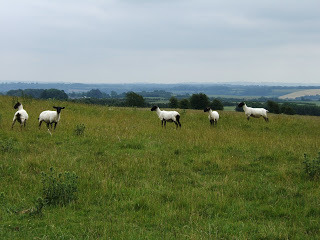 Marlborough Down near Rockley. Photo courtesy of E. Chadwick.
Marlborough Down near Rockley. Photo courtesy of E. Chadwick.
At some point in the early 1150s John built a castle at Newbury. The whereabouts of this place is now unknown and there has been much speculation as to where it was. As far as I'm concerned, the answer is staring everyone in the face. It's at Speen, on high ground overlooking various strategic roads. The bishop of Salisbury was known to have a house here, and as we gave already seen in the paragraph above: 'He built castles designed with wondrous skill, in the places that best suited him; the lands and possessions of the churches he brought under his own lordship, driving out the owners whatever order they might belong to.' Wherever the castle is, John fortified a position in the Newbury area and held it for the Empress. In the summer of 1152 King Stephen besieged it on his way to try and take Wallingford. With Brian FitzCount out of the reckoning, having taken the cowl, John Marshal was the Angevins' last hope to protect Wallingford from Stephen's advance.
The first assault battered John's troops badly, but they didn't give in. Stephen didn't want to sit down to besiege it. I suspect he knew how hard John Marshal could stand and that he would sell the castle very dearly. John in his turn knew he was in a dire situation and couldn't hold out for much longer. He didn't have the men and supplies necessary. He asked Stephen for time to gain honourable permission from the Empress to surrender the castle. Stephen agreed, but told John that he must provide hostages and pledges for his good word. John agreed to do so and handed over as one of them, his small son William, who would have been around five or six years old.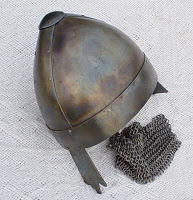 Norman helm belonging to E. Chadwick.
Norman helm belonging to E. Chadwick.
With the time he had been given, John set about stuffing his keep to the rafters with men and supplies. Why did he do this when he could have yielded? I suspect it was because he was buying time for Wallingford and for Henry FitzEmpress. Each day that he stood, was a day gained for the Angevin cause. John Marshal hadn't backed down at Wherwell, where his stand had allowed the Empress to escape. He hadn't backed down before the superior strength of Patrick of Salisbury, and he wasn't going to back down now, even if it meant gambling with his son's life. Stephen duly came on the appointed day to demand the surrender of the castle and John refused him and told him he would fight. When threatened with the execution of little William by hanging, John uttered those by now infamous words. 'Il dist ken e li chaleit de l'enfant, quer encore aveit les enclumes e les marteals dunt forgereit de plus beals' (He said that he did not care about the child, since he still had the anvils and hammers to produce even finer ones.)
Callous father? Cool brinkman gambling with his son's life? A man caught between a rock and a hard place and doing what he must to safeguard others? It becomes a tough call, but I will say that there is far more going on under the surface than a cursory glance informs, and that it is vital for anyone studying this incident to read it through the lens of medieval mindset. It's not what's on top that matters here, but what's underneath.
Stephen could not bring himself to hang the boy, although for a time William was the plaything and victim of the royal camp, as he was also threatened with being flung from a catapult and squashed whilst strapped to a hurdle intended to attack the castle gate. This is often not mentioned in the various secondary source narratives concerning the incident. From what I have garnered elsewhere, young squires and captive sons were frequently subjected to such torments – rather like the traditional 'punishment details' for youths at public school. Stephen took William into his household and John Marshal's son seems to have settled well in his new life. He was happy and confident enough despite his ordeal to want to play a game with King Stephen, involving jousting with plaintain leaves. One wonders how such a chirpy, confident, secure little boy could have been born of such supposed parental indifference. A servant was sent to keep an eye on William, 'because his family had great fears that he would come to harm' (Histoire de Guillaume le Mareschal) but was caught in the act and chased away.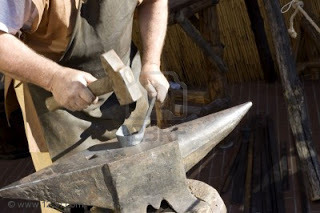 An anvil. One can see clearly what John Marshal MIGHT have been punning at!
An anvil. One can see clearly what John Marshal MIGHT have been punning at!
Another point to note is to wonder whether those words were ever actually said, or if it was the poet, writing the Histoire de Guillaume le Mareschal, 80 years later, who used them as a dramatic motif. The anvils and hammers were symbols of a marshal and there were existing medieval stories involving tales of children being threatened with death unless the father cut off his own testicles. Not so John Marshal. He still had his intact! So the reference to 'anvils and hammers' may well be a motif for John's cool, daring, virility and occupation, rather than proof that he actually ever said the words. We will never know. If he did, it was clever punning on various pertinent symbols that everyone understood in his day. [See photo.]
John's castle at Newbury eventually fell to Stephen, but John had managed to buy that extra time for Wallingford. Stephen moved up to invest the latter and Henry came from Normandy to oppose him. Eventually a treaty was agreed whereby Stephen would keep the throne in his lifetime and Henry would inherit it on his death. Although there were a few more skirmishes, the long civil war was in essence over.
Stephen died in 1154 and Henry FitzEmpress, at the age of twenty-one, became King of England. Life slowly settled down. It is likely that John's final son Henry was born at this time and named for the new power in the country. Henry set about restoring order. All adulterine castles were to be destroyed, and I suspect this is what happened to Newbury. Certainly there is no trace of it today. Henry also took several castles back into his own power, including Marlborough. John was allowed to keep the manors of Wexcombe and Cherhill that Stephen had granted him, but only for his lifetime; it was not to be a hereditary right. John continued to serve Henry as his master marshal, but the King had his own new men to promote and John was of the 'old regime.' Many of the gains made in the period of the war were lost, but John had still played his hand well, and while his fortunes diminished, he nevertheless had created a fine platform from which his offspring could leap to greatness.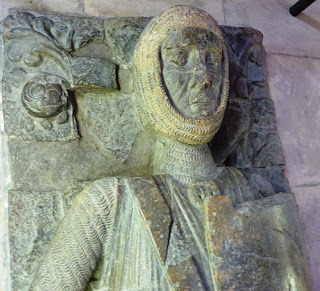 William Marshal's effigy at Temple Church, London. Photo courtesy of E. Chadwick.
William Marshal's effigy at Temple Church, London. Photo courtesy of E. Chadwick.
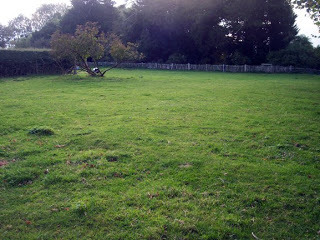 Bradenstoke Priory "church" at place where altar and tombs would have been, looking west.
Bradenstoke Priory "church" at place where altar and tombs would have been, looking west.
Photo by Christy K. Robinson.William did so in spectacular fashion, going on to become Earl of Pembroke and regent of England. Henry Marshal, as aforementioned, was to become bishop of Exeter. More distant descendants of John Marshal include Robert the Bruce, Anne Boleyn, Elizabeth I, George Washington and Winston Churchill. John died in 1165, around the age of 60, which is as much as we know about his demise, although it may be telling that he made a grant to Bradenstoke Priory of half of the township of Easton, in the presence of his wife, two of earl Patrick's chaplains, his chamberlain Osbert and Ralph the Physician. Was the physician there because he just happened to be handy and a man of learning, or was he there because of medical difficulties? John was buried at Bradenstoke Priory, the foundation of his marital relatives the Earls of Salisbury. His tomb and Sybilla's have been lost, but their bones rest somewhere beneath the grass and tumbled stones of the priory ruins.
I can say without a doubt and from personal experience that their spirits live on and John's is a particularly vibrant one still!
Select bibliography:
THE CARTULARY OF BRADENSTOKE PRIORY Edited by Vera C.M. London. Wiltshire Record Society 1979
DIALOGUS DE SCACCARIO. The Course of the Exchequeur and CONSTITUTIO DOMUS REGIS. The Establishment of the King's Household. Edited and translated by the late Charles Johnson. Clarendon Press Oxford. POD ISBN 0198222688
WILLIAM MARSHAL. Court Career & Chivalry in the Angevin Empire 1147-1219 by David Crouch. Longman 1990 ISBN 0582037867
WILLIAM MARSHAL. Knight Errant, Baron and Regent of England By Sidney Painter. John Hopkins Press 1967
HISTORY OF WILLIAM MARSHAL VOL 1. Text and Translation (11. 1-10031) ed. by A.J. Holden with English translations by S.Gregory and D. Crouch. Anglo Norman Text Society ISBN 0905474422
HISTORY OF WILLIAM MARSHAL VOL II ed by A.J. Holden with English translation by S. Gregory and D. Crouch. Anglo Norman Text Society occasional publications series 5 2004. ISBN 0905474457
HISTORY OF WILLIAM MARSHAL VOL III ed by A.J. Holden. Historical notes by D. Crouch. Anglo Norman Text Society 2006 ISBN 0905474481
WILLIAM MARSHAL EARL OF PEMBROKE By Catherine A. Armstrong. Seneschal Press 2006 ISBN 978169530385
THE BIGOD EARLS OF NORFOLK IN THE THIRTEENTH CENTURY By Marc Morris. Boydell 2005. ISBN 1843831643
__________________
Thank you so much, Elizabeth. As I continue to research and write my own historical novel of the 17th century, I have you and Sharon Kay Penman to thank for setting such astronomically-high standards for research methods, literary skill, and really, creating the vast and hungry market for intelligently-written historical fiction. (It's both daunting and enervating to make my bid to be your colleague!)
MORE on Elizabeth Chadwick and her historical novels, blogs, research methods, and links to Facebook and Twitter: http://www.elizabethchadwick.com/index.php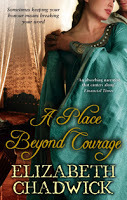 A Place Beyond Courage, a novel by Elizabeth Chadwick, tells the vibrant, heart-pounding story of John FitzGilbert Marshal. If he weren't my grandfather times 30 or so, I'd say Elizabeth's portrayal of John makes him rather "hot." Haha!
The Greatest Knight
and
The Scarlet Lion
, also by Elizabeth Chadwick, are two stand-alone novels on the life of John Marshal's son, William Marshal. If you haven't read her books, get thee to a bookstore now (online or bricks and mortar) and get started! To Defy a King is now selling in Costco, too. I mean, please, how easy can it be, people?
A Place Beyond Courage, a novel by Elizabeth Chadwick, tells the vibrant, heart-pounding story of John FitzGilbert Marshal. If he weren't my grandfather times 30 or so, I'd say Elizabeth's portrayal of John makes him rather "hot." Haha!
The Greatest Knight
and
The Scarlet Lion
, also by Elizabeth Chadwick, are two stand-alone novels on the life of John Marshal's son, William Marshal. If you haven't read her books, get thee to a bookstore now (online or bricks and mortar) and get started! To Defy a King is now selling in Costco, too. I mean, please, how easy can it be, people? 
John FitzGilbert Marshal is 32 generations removed from me. The Marshal clan married to the families of, and were "in-laws" of de Clare, Llewellyn Prince of Wales, John King of England, Quincy, Bigod, Tosny, Ferrers, de Braose, de Bohun, Salisbury, Gloucester, FitzWalter, Mortimer, de Lacy, Percy, Neville—to name a few. Take us back to the twelfth century, please, Elizabeth!
John FitzGilbert Marshal's iron anvil
 Guest author Elizabeth Chadwick
Guest post by Elizabeth Chadwick
Guest author Elizabeth Chadwick
Guest post by Elizabeth Chadwick
Many thanks to Christy for inviting me along to talk on her blog.
I want to tell you about a mediaeval nobleman called John Marshal. His fourth son, William, is justly famous among medievalists and those in the know, for being the greatest knight of the Middle Ages and with a reputation that still resonates today.
John Marshal's reputation has considerably less burnish than his illustrious son's and has suffered at the hands of modern novelists and due to a mindset among modern readers that frequently does not allow for the rules and realities of life in the difficult mid-12th century. To understand John Marshal, his deeds, dilemmas, and decisions, one needs to view him through the lens of that period, and only then does the living, breathing man emerge with energetic clarity.
Professor David Crouch, historian and senior authority on the Marshals in the academic community, says of John Marshal:
"John Marshal was a formidable model for his son: astute, politically powerful, and easy companion in the Royal Chambers, and a called warrior in the field… He was no coarse bandit and played the great game of politics with talent and perception… John Marshal was a definitive man of standing in his son's eyes."
John FitzGilbert Marshal was probably born in the southwest of England, most likely Wiltshire or Berkshire around the year 1105. His father was a Marshal at the court of King Henry I and we know his name was Gilbert Giffard. The appellation is a fairly common Norman one, meaning 'chubby cheeks.' John's younger brother William, entered holy orders and had the living of the church of Cheddar in Somerset. He went on to become chancellor to the Empress Matilda. If there were other siblings they have not come down to us in history. We also don't know the name of John Marshal's mother, although some genealogy sites suggest that she was a de Venoix and perhaps called Heloise. Venoix is very close to Caen in the Calvados region of Normandy where many of William the Conqueror's followers came from. There was also a royal marshal called Robert de Venoix, so it can be speculated that the families by association of work, formed a closer bond through marriage. I must stress that John's maternal parentage is open to debate and not hard fact.
Gilbert the Marshal had estates provided for him to live off what he performed his duties at court. These included Tidworth in Wiltshire and Nettlecome in Somerset. The family had estates in Devon and possessed seven and a half knights' fees for scattered estates held for various landlords including the Dean of Glastonbury. Hamstead, now Hampstead Marshall in Berkshire, was also probably a holding. There is a 13th-century mention of the marshal's right to Hamstead and the Grange at Speen for services of the Marshal's Rod. Speen lies just outside Newbury on an area of strategically valuable high land overlooking the modern town.
The Marshal family were of minor nobility but ambitious to change that. There were middle-ranking royal civil servants on the make. The Marshal's duties were numerous, and since John followed his father into the position, he must have learned the ropes from an early age. The word Marshal comes from Marescallus, meaning 'Horse Slave,' and at one time they had been stable hands under the control of the Constable's department. Although the office rose from these humble beginnings, the marshal's work was much concerned with horses and transport and keeping order. The marshals had their own department at court and there were several of them although with a Master Marshal in charge of all. This was a somewhat fluid position when John was growing up and there was a certain amount of jockeying for position within the ranks.
The marshal's duties included seeing that the stables were properly run and supplied and providing harness and mounts for those in need of them. The job also involved dealing with the kennels and the mews. It was the marshal's task to provide carts for transport when the court was on the move. He had to find lodging for the household and keep order at the court. As a symbol of the latter office, he carried the Marshal's Rod – a kind of ceremonial stick or mace and still in evidence today with the title of 'Black Rod' and said mace being held by the officer in charge of the ushers of the Houses of Parliament. In the 12th century, the Marshal had to ensure that the 'verge' was observed. A verge was a personal space between the king and any supplicant. Take a step too far and the Marshal's rod would make sure you knew you had transgressed! The Marshal was in charge of the ushers who saw to it that only desirables got in to see the king. They were the club bouncers of their day so to speak. We know that two of John's ushers were called Gilbert Bonhomme and Ralf. Another aspect of the job was dealing with the 'ladies of the night' who serviced the court. The Marshal had to keep the working girls in line and regulate their activities. There were fines for unruly behaviour, and one suspects that this was an area where backhanders and insider dealing frequently went on.
The Marshal also had to sit at the exchequer. It was his task to take responsibility for anyone who couldn't pay their debts, and his department maintained the debtor's prison. Being in there would cost a sheriff or a bailiff half a mark for every night they were in custody. On top of this he kept the tallies of all the wages owed to the King's troops when in the field and saw that they were paid, for which he was entitled to a portion of that wage bill. Perks of the job included being entitled to every black and white horse taken on a battle campaign! Each time a noble's son was knighted at court, the marshal was entitled to a payment of a palfrey or a saddle. The Master Marshal's daily wage was two shillings and he was entitled to bread, wine and candles whilst working at court. There were also 'backhander' perks from barons higher up the food chain who thought that a bit of glad-handing in the form of grants of land was useful in order to keep the king's marshal sweet.
When John was in his mid-twenties, he and his father had to fight for their right to be the Master Marshals of the court. Two of the other Marshals, Robert de Venoix and William de Hastings were claiming the post, but John and his father were successful in their petition, which probably took the form of a trial by combat. John's father died around 1129 or 1130 and John inherited his position at court, although he had to pay 40 marks for the privilege. This included the office of 'avener' or provider of provender. To inherit his lands, he had to pay the death duty of £22 13s and 4d. Some time over the next few years, he married an heiress of modest worth with lands adjoining his own Wiltshire and Berkshire interests. She was called Aline Pipard and her main estate was at Clyffe Pypard in Wiltshire, not so far from John's own territories. It was a good solid match, although not a spectacular one.
 Ludgershall Castle, a holding of John Marshal's. Photo courtesy of E. Chadwick.
Ludgershall Castle, a holding of John Marshal's. Photo courtesy of E. Chadwick. Aline bore John two sons – Walter and Gilbert. In 1135 King Henry I died and the country was thrown into turmoil as two claimants jostled for the crown – Henry's daughter Matilda, and her cousin, Stephen. Initially, John swore fealty to Stephen and was granted the castles of Ludgershall and the town and castle of Marlborough in Wiltshire in reward. Stephen's generosity gave John a strong power base and made him formidable in the Kennet Valley and northeast Wiltshire.
In 1139, the Empress Matilda came to England and made her bid to take the crown from Stephen. For whatever reason, Stephen suspected John Marshal of duplicity and besieged him at Marlborough. My personal opinion is that John had fallen foul of the factions at court who thought he had been receiving too many favours, and felt that he should be put in his place. He had no strong affinities at Stephen's court and a man isolated was a man who could be picked off and brought down. I think John jumped before he was pushed (off the mortal coil). Speculation aside, what is known is that John swore for the Empress and adhered to her cause for the rest of the Civil War. His brother William joined her entourage as her chancellor and remained with her until at least 1151. Unfortunately for John, the Empress's attempt to regain the throne was not plain sailing and to cut a long story short, she lost her advantage and while besieging the Bishop of Winchester at his palace of Wolvesely, she was almost captured. John was a few miles out of Winchester, dealing with a supply problem, when he heard that the troops of William D'Ypres, a Flemish mercenary in the pay of Stephen's queen, were coming down the Andover road straight for him. If D'Ypres managed to break through, John knew that Winchester would be encircled and the Empress captured. John made his stand at Wherwell where there was a ford over the river Teste beside a Benedictine nunnery that had been founded by an Anglo Saxon queen in the late 10th century.
 River Teste at Wherwell. Photo courtesy of E. Chadwick.
River Teste at Wherwell. Photo courtesy of E. Chadwick.John fought for as long as he could, but with D'Ypres' numbers too great to withstand, he retreated into the nunnery and barricaded himself in. D'Ypres knew he couldn't leave a man like John Marshal to create mayhem in his rear, so he ordered the nunnery to be burned along with the men inside it. There was mayhem and chaos. Some of the troops fled the burning church only to meet their end on the edges of the mercenary's swords. John barricaded himself in the tower with another knight and refused to come out. When his companion feared for their lives and wanted to surrender, John told him that he would kill him with his own hands if he mentioned that word again. They stayed put, but John paid the price when molten lead from the church roof landed on his face and burned out his eye. Once D'Ypres' force had moved on, John staggered from the church with his companion, and the two of them made their way to safety. This must have been something of a feat because that safety was 25 miles away at Marlborough; they were on foot, and John had suffered a terrible facial injury.
Nevertheless, they made it and once recovered, John set out to recoup and regroup. Modern novelists and readers studying this detail sometimes dismiss John's actions as those of a lunatic adrenaline junkie, but I don't believe that is the case at all. Like a commander in World War II ordered to hold a particular bridge against the enemy in dire circumstances, he did so. He did his duty; he did what he had to do despite the terrible odds against him, and that to me is a man who knows what his word of honour is worth and what doing your duty really means.
 Model of Sarum/Salisbury in the 12th century.John's most powerful neighbour in the region was Walter of Salisbury, hereditary sheriff of Salisbury (nowadays called Old Sarum). Walter himself came from a paternal Anglo Saxon line that had survived the Norman Conquest. When Walter died, his son William succeeded him, but died not long after the battle of Wilton in 1143. The second son, Patrick, became lord of Salisbury and he supported Stephen. Looking to curtail his forceful neighbour in the Kennet valley, Patrick took up arms against John. John ably defended himself, although he had fewer resources than Patrick, and even if often on the back foot, it was never defeat. Eventually Robert Earl of Gloucester, the Empress's brother and chief general, stepped between the men. He offered Patrick an earldom if he would come over to the Empress and he suggested that John divorce his wife and marry Patrick's sister to make peace between them. The men agreed and sometime between 1144 and 1145, John Marshal annulled his marriage to Aline and took Sybilla FitzWalter to wife. Aline was remarried to Gloucester's uncle, a widower called Philip de Gay or de Gai. On the surface, John's action may seem harsh, but again, that's to judge him by the standards of our day, not the 12th century. By doing what he did, he turned a 'you will lose' situation into a 'you might win' one and stabilised life for himself and his dependents. Aline was not disparaged by her remarriage, and his sons retained their inheritance.
Model of Sarum/Salisbury in the 12th century.John's most powerful neighbour in the region was Walter of Salisbury, hereditary sheriff of Salisbury (nowadays called Old Sarum). Walter himself came from a paternal Anglo Saxon line that had survived the Norman Conquest. When Walter died, his son William succeeded him, but died not long after the battle of Wilton in 1143. The second son, Patrick, became lord of Salisbury and he supported Stephen. Looking to curtail his forceful neighbour in the Kennet valley, Patrick took up arms against John. John ably defended himself, although he had fewer resources than Patrick, and even if often on the back foot, it was never defeat. Eventually Robert Earl of Gloucester, the Empress's brother and chief general, stepped between the men. He offered Patrick an earldom if he would come over to the Empress and he suggested that John divorce his wife and marry Patrick's sister to make peace between them. The men agreed and sometime between 1144 and 1145, John Marshal annulled his marriage to Aline and took Sybilla FitzWalter to wife. Aline was remarried to Gloucester's uncle, a widower called Philip de Gay or de Gai. On the surface, John's action may seem harsh, but again, that's to judge him by the standards of our day, not the 12th century. By doing what he did, he turned a 'you will lose' situation into a 'you might win' one and stabilised life for himself and his dependents. Aline was not disparaged by her remarriage, and his sons retained their inheritance.John and Sybilla swiftly began a second family. It is perhaps telling that he only had two sons by his first wife in the course of fifteen years and six (and perhaps seven) offspring with Sybilla over the same period. The first was born within a year of the marriage and christened John for his father. The second, destined for fame and legend was William, born in either 1146 or 1147. We know for certain there were two daughters, Sybilla and Marguerite, and two more sons, Ancel and Henry. Henry went on to become bishop of Exeter and was probably born after Henry II had gained the throne. Ancel became a household knight in the service of his cousin, Rotrou, Count of Perche. Around the time that John married Sybilla, Sybilla's sister Hawise married Robert de Dreux, brother of Louis VII of France [first husband of Eleanor of Aquitaine], thus making a distant connection between the Marshals and French royalty.
In England, the fighting continued and the Empress's position grew more desperate as her adherents either gave up or died. She lost her stalwart supporter Miles of Gloucester when he was accidentally shot by one of his own men whilst out hunting. Her half-brother Robert of Gloucester died, and her close friend and supporter Brian FitzCount retired to a monastery. The Empress herself departed England in 1148 and did not return, but her son Henry was waiting in the wings and growing up fast.
For John Marshal the period covered by the late 1140's up to 1153 was a continuing dark time when he was involved in a war of slow grinding attrition. His lands were burned and ravaged by Eustace, the son of King Stephen and the best that John could manage was to grit his teeth and endure – which he did. He was known as a man of great cunning, a builder of castles 'designed with wondrous skill' and a man well able to attract men to his banner. Although a generous benefactor to the Church, he was still vilified by certain bishops and clergy. He was excommunicated for raiding church lands and forcing the church to answer in his secular court. He also made the church's tenants build his castles for him, which did not go down well. (Gesta Stephani). John seems to have taken the excommunication stoically and to have treated it as a hazard of the job, so to speak. John's relationship with the Church was not all bad-feeling and acrimony. He was, in fact, a generous patron. He donated his house and lands in Winchester on Jewry Street to Troarn Abbey in 1148. He gave lands at his manor of Rockley to the Templars and he was a benefactor of Bradenstoke Priory [Christy's photos and description at link], where he was eventually to be buried.
 Marlborough Down near Rockley. Photo courtesy of E. Chadwick.
Marlborough Down near Rockley. Photo courtesy of E. Chadwick.At some point in the early 1150s John built a castle at Newbury. The whereabouts of this place is now unknown and there has been much speculation as to where it was. As far as I'm concerned, the answer is staring everyone in the face. It's at Speen, on high ground overlooking various strategic roads. The bishop of Salisbury was known to have a house here, and as we gave already seen in the paragraph above: 'He built castles designed with wondrous skill, in the places that best suited him; the lands and possessions of the churches he brought under his own lordship, driving out the owners whatever order they might belong to.' Wherever the castle is, John fortified a position in the Newbury area and held it for the Empress. In the summer of 1152 King Stephen besieged it on his way to try and take Wallingford. With Brian FitzCount out of the reckoning, having taken the cowl, John Marshal was the Angevins' last hope to protect Wallingford from Stephen's advance.
The first assault battered John's troops badly, but they didn't give in. Stephen didn't want to sit down to besiege it. I suspect he knew how hard John Marshal could stand and that he would sell the castle very dearly. John in his turn knew he was in a dire situation and couldn't hold out for much longer. He didn't have the men and supplies necessary. He asked Stephen for time to gain honourable permission from the Empress to surrender the castle. Stephen agreed, but told John that he must provide hostages and pledges for his good word. John agreed to do so and handed over as one of them, his small son William, who would have been around five or six years old.
 Norman helm belonging to E. Chadwick.
Norman helm belonging to E. Chadwick.With the time he had been given, John set about stuffing his keep to the rafters with men and supplies. Why did he do this when he could have yielded? I suspect it was because he was buying time for Wallingford and for Henry FitzEmpress. Each day that he stood, was a day gained for the Angevin cause. John Marshal hadn't backed down at Wherwell, where his stand had allowed the Empress to escape. He hadn't backed down before the superior strength of Patrick of Salisbury, and he wasn't going to back down now, even if it meant gambling with his son's life. Stephen duly came on the appointed day to demand the surrender of the castle and John refused him and told him he would fight. When threatened with the execution of little William by hanging, John uttered those by now infamous words. 'Il dist ken e li chaleit de l'enfant, quer encore aveit les enclumes e les marteals dunt forgereit de plus beals' (He said that he did not care about the child, since he still had the anvils and hammers to produce even finer ones.)
Callous father? Cool brinkman gambling with his son's life? A man caught between a rock and a hard place and doing what he must to safeguard others? It becomes a tough call, but I will say that there is far more going on under the surface than a cursory glance informs, and that it is vital for anyone studying this incident to read it through the lens of medieval mindset. It's not what's on top that matters here, but what's underneath.
Stephen could not bring himself to hang the boy, although for a time William was the plaything and victim of the royal camp, as he was also threatened with being flung from a catapult and squashed whilst strapped to a hurdle intended to attack the castle gate. This is often not mentioned in the various secondary source narratives concerning the incident. From what I have garnered elsewhere, young squires and captive sons were frequently subjected to such torments – rather like the traditional 'punishment details' for youths at public school. Stephen took William into his household and John Marshal's son seems to have settled well in his new life. He was happy and confident enough despite his ordeal to want to play a game with King Stephen, involving jousting with plaintain leaves. One wonders how such a chirpy, confident, secure little boy could have been born of such supposed parental indifference. A servant was sent to keep an eye on William, 'because his family had great fears that he would come to harm' (Histoire de Guillaume le Mareschal) but was caught in the act and chased away.
 An anvil. One can see clearly what John Marshal MIGHT have been punning at!
An anvil. One can see clearly what John Marshal MIGHT have been punning at! Another point to note is to wonder whether those words were ever actually said, or if it was the poet, writing the Histoire de Guillaume le Mareschal, 80 years later, who used them as a dramatic motif. The anvils and hammers were symbols of a marshal and there were existing medieval stories involving tales of children being threatened with death unless the father cut off his own testicles. Not so John Marshal. He still had his intact! So the reference to 'anvils and hammers' may well be a motif for John's cool, daring, virility and occupation, rather than proof that he actually ever said the words. We will never know. If he did, it was clever punning on various pertinent symbols that everyone understood in his day. [See photo.]
John's castle at Newbury eventually fell to Stephen, but John had managed to buy that extra time for Wallingford. Stephen moved up to invest the latter and Henry came from Normandy to oppose him. Eventually a treaty was agreed whereby Stephen would keep the throne in his lifetime and Henry would inherit it on his death. Although there were a few more skirmishes, the long civil war was in essence over.
Stephen died in 1154 and Henry FitzEmpress, at the age of twenty-one, became King of England. Life slowly settled down. It is likely that John's final son Henry was born at this time and named for the new power in the country. Henry set about restoring order. All adulterine castles were to be destroyed, and I suspect this is what happened to Newbury. Certainly there is no trace of it today. Henry also took several castles back into his own power, including Marlborough. John was allowed to keep the manors of Wexcombe and Cherhill that Stephen had granted him, but only for his lifetime; it was not to be a hereditary right. John continued to serve Henry as his master marshal, but the King had his own new men to promote and John was of the 'old regime.' Many of the gains made in the period of the war were lost, but John had still played his hand well, and while his fortunes diminished, he nevertheless had created a fine platform from which his offspring could leap to greatness.
 William Marshal's effigy at Temple Church, London. Photo courtesy of E. Chadwick.
William Marshal's effigy at Temple Church, London. Photo courtesy of E. Chadwick. Bradenstoke Priory "church" at place where altar and tombs would have been, looking west.
Bradenstoke Priory "church" at place where altar and tombs would have been, looking west. Photo by Christy K. Robinson.William did so in spectacular fashion, going on to become Earl of Pembroke and regent of England. Henry Marshal, as aforementioned, was to become bishop of Exeter. More distant descendants of John Marshal include Robert the Bruce, Anne Boleyn, Elizabeth I, George Washington and Winston Churchill. John died in 1165, around the age of 60, which is as much as we know about his demise, although it may be telling that he made a grant to Bradenstoke Priory of half of the township of Easton, in the presence of his wife, two of earl Patrick's chaplains, his chamberlain Osbert and Ralph the Physician. Was the physician there because he just happened to be handy and a man of learning, or was he there because of medical difficulties? John was buried at Bradenstoke Priory, the foundation of his marital relatives the Earls of Salisbury. His tomb and Sybilla's have been lost, but their bones rest somewhere beneath the grass and tumbled stones of the priory ruins.
I can say without a doubt and from personal experience that their spirits live on and John's is a particularly vibrant one still!
Select bibliography:
THE CARTULARY OF BRADENSTOKE PRIORY Edited by Vera C.M. London. Wiltshire Record Society 1979
DIALOGUS DE SCACCARIO. The Course of the Exchequeur and CONSTITUTIO DOMUS REGIS. The Establishment of the King's Household. Edited and translated by the late Charles Johnson. Clarendon Press Oxford. POD ISBN 0198222688
WILLIAM MARSHAL. Court Career & Chivalry in the Angevin Empire 1147-1219 by David Crouch. Longman 1990 ISBN 0582037867
WILLIAM MARSHAL. Knight Errant, Baron and Regent of England By Sidney Painter. John Hopkins Press 1967
HISTORY OF WILLIAM MARSHAL VOL 1. Text and Translation (11. 1-10031) ed. by A.J. Holden with English translations by S.Gregory and D. Crouch. Anglo Norman Text Society ISBN 0905474422
HISTORY OF WILLIAM MARSHAL VOL II ed by A.J. Holden with English translation by S. Gregory and D. Crouch. Anglo Norman Text Society occasional publications series 5 2004. ISBN 0905474457
HISTORY OF WILLIAM MARSHAL VOL III ed by A.J. Holden. Historical notes by D. Crouch. Anglo Norman Text Society 2006 ISBN 0905474481
WILLIAM MARSHAL EARL OF PEMBROKE By Catherine A. Armstrong. Seneschal Press 2006 ISBN 978169530385
THE BIGOD EARLS OF NORFOLK IN THE THIRTEENTH CENTURY By Marc Morris. Boydell 2005. ISBN 1843831643
__________________
Thank you so much, Elizabeth. As I continue to research and write my own historical novel of the 17th century, I have you and Sharon Kay Penman to thank for setting such astronomically-high standards for research methods, literary skill, and really, creating the vast and hungry market for intelligently-written historical fiction. (It's both daunting and enervating to make my bid to be your colleague!)
MORE on Elizabeth Chadwick and her historical novels, blogs, research methods, and links to Facebook and Twitter: http://www.elizabethchadwick.com/index.php
 A Place Beyond Courage, a novel by Elizabeth Chadwick, tells the vibrant, heart-pounding story of John FitzGilbert Marshal. If he weren't my grandfather times 30 or so, I'd say Elizabeth's portrayal of John makes him rather "hot." Haha!
The Greatest Knight
and
The Scarlet Lion
, also by Elizabeth Chadwick, are two stand-alone novels on the life of John Marshal's son, William Marshal. If you haven't read her books, get thee to a bookstore now (online or bricks and mortar) and get started! To Defy a King is now selling in Costco, too. I mean, please, how easy can it be, people?
A Place Beyond Courage, a novel by Elizabeth Chadwick, tells the vibrant, heart-pounding story of John FitzGilbert Marshal. If he weren't my grandfather times 30 or so, I'd say Elizabeth's portrayal of John makes him rather "hot." Haha!
The Greatest Knight
and
The Scarlet Lion
, also by Elizabeth Chadwick, are two stand-alone novels on the life of John Marshal's son, William Marshal. If you haven't read her books, get thee to a bookstore now (online or bricks and mortar) and get started! To Defy a King is now selling in Costco, too. I mean, please, how easy can it be, people?
Published on April 17, 2011 16:44
March 7, 2011
Coming soon: guest post from author Elizabeth Chadwick
Coming soon: a guest post by one of my favorite authors, Elizabeth Chadwick. On a blog tour, she's promoting the March 2011 US release of her book
To Defy A King
, the story of Maud/Matilda/Mahelt Marshal, daughter (and third-born) of William Marshal (my ancestor).
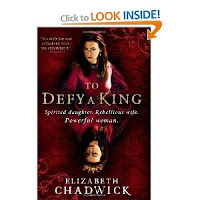 Mahelt is not my ancestor, but she is closely related. She was the sister of Isabella and Eva Marshal, and sister-in-law, daughter-in-law, aunt, or niece to Llewellyn Prince of Wales, John King of England, and the families of Quincy, Bigod, Tosny, Ferrers, de Clare, de Braose, and de Bohun. (Many others, too, that I'm not descended from.)
Mahelt is not my ancestor, but she is closely related. She was the sister of Isabella and Eva Marshal, and sister-in-law, daughter-in-law, aunt, or niece to Llewellyn Prince of Wales, John King of England, and the families of Quincy, Bigod, Tosny, Ferrers, de Clare, de Braose, and de Bohun. (Many others, too, that I'm not descended from.)
Have you noticed the effigy photos in my blog header? The two upright effigies are at Coverham, Yorkshire. They represent Robert and Ranulf, lords of Middleham, Yorkshire a handful of miles away. Ranulf makes a few appearances in To Defy a King, being the brother-in-law of Mahelt's first husband, Hugh Bigod. Robert and Ranulf, father and son, were ancestors of the Nevilles, who get most of the hits in my blog stats!
If you're interested in the heart and soul of who our shared ancestors were, as I am, you'd be wise to collect Elizabeth's historical novels. I've read all but one or two, and let me tell you, she can't write a page without mentioning the people from whom I sprang! She's no medieval name-dropper, but a solid researcher, historical re-enactor, and best of all, an exciting, award-winning novelist. I'm writing a novel on ancestor Mary Barrett Dyer (1611-1660), and I aspire to both the scholarship and artistry of Elizabeth Chadwick.
So stay tuned: Elizabeth's blog post will appear here very soon.
Below is my list of connections within the William Marshal and Isabel de Clare brood. I've highlighted the individuals who are my direct ancestors. To summarize, two of their children were my ancestors, but most of their children were married to those who would become my ancestors in other, later, marriages. Medieval mating—wow, who knew?
Children of William Marshal & Isabel de Clare:1. William Marshal, 2nd Earl of Pembroke (~1190-April 6 1231), married (1) Alice de Betun, daughter of Earl of Albemarle; (2) April 23 1224 Eleanor Plantagenet, daughter of King John of England 2. Richard Marshal, 3rd Earl of Pembroke (>1190-April 16 1234), married Gervase le Dinant. 3. Maud /Mahelt /Matilda Marshal (1192-March 27, 1248), married (1) Hugh Bigod, 3rd Earl of Norfolk (son of my ancestors Roger Bigod and Ida de Tosny); (2) William de Warenne, 6th Earl of Surrey by whom Maud had a son and daughter, Isabelle de Warrenne, who married Hugh d'Aubigny/Albini (they had no children). Hugh was the brother of my ancestor, Isabella d'Aubigny/Albini (married to John Fitzalan, earl of Arundel after Hugh d'Aubigny died); Maud married (3) Walter de Dunstanville. 4. Gilbert Marshal, 4th Earl of Pembroke (d. June 27 1241), married (1) Margaret of Scotland, daughter of King William I of Scotland; (2) Maud de Lanvaley 5. Walter Marshal, 5th Earl of Pembroke (>1198 - November 1245), married Margaret de Quincy, daughter of Hugh de Kevelioc, 3rd Earl of Chester. They had no children. But Margaret married her brother-in-law, William de Ferrers, and I am descended from them. 6. Anselm Marshal, 6th Earl of Pembroke (d. December 22 1245), married Maud de Bohun, daughter of Humphrey de Bohun, 2nd Earl of Hereford. 7. Isabella Marshal (October 9 1200 - January 17 1240), married (1) Gilbert de Clare, 5th Earl of Hertford, October 9 1217. Gilbert de Clare Earl of Gloucester was son of Sir Richard FitzRoger de Clare Earl of Hertford and Amicia FitzRobert Countess of Gloucester. Isabella married (2) Richard of Cornwall Plantagenet Earl of Cornwall, son of John King of England and Isabella Taillefer d'Angoulême, 13 Mar 1231 Fawley Church, Buckinghamshire, England; Isabella died 15 Jan 1240 Berkhamsted Castle, Hertfordshire, England, at age 39; buried after 15 Jan 1240 Beaulieu Abbey, Hampshire, England. 8. Sibyl (or Sybilla) Marshal, married William de Ferrers, 5th Earl of Derby. Sibilla (d ante 1238) married, before 1219, William de Ferrers, earl of Derby, and they had seven daughters, though I'm descended from NONE of them! (Sheesh, what are the odds?) These daughters were: Agnes (d1290) who married William de Vesci of Alnwick; Isabel (d1260) who married Gilbert Basset of Wycombe; Maud (d 1299) who married Simon de Kyme of Sotby; Sybil (d 1173/4) who married Franco de Bohun of Midhurst; Joan (d1268) who married John de Mohun of Dunster; Agatha (d1306) who married Hugh de Mortimer of Chelmarsh; and Eleanor (d1274) who married William de Vaux. Sibilla died after 1238. William de Ferrers (d. 1254) then married Margaret de Quincy (widow of William Marshal above) in or after 1238, from whom I am descended.9. Eva Marshal married William de Braose, Lord of Abergavenny, son of Reginald de Braose, before 1219. They had four daughters, and William de Braose was hanged by Llywelyn ap Iorwerth in 1230. William was accused of having dallied with Llywelyn's wife Joan, bastard of King John. Eve's and de Braose's daughters were: Maud/Matilda (d1301) who married Roger de Mortimer of Wigmore; Isabel who married (1229) David (d1246), son of Llywelyn ap Iorwerth; Eve (d1255) who married William de Cantelou; and Eleanor (d c 1250) who married Humphrey VI de Bohun earl of Hereford. 10. Joan (or Joanna) Marshal, married Warin de Montchensy, Lord Swanscombe.

 Mahelt is not my ancestor, but she is closely related. She was the sister of Isabella and Eva Marshal, and sister-in-law, daughter-in-law, aunt, or niece to Llewellyn Prince of Wales, John King of England, and the families of Quincy, Bigod, Tosny, Ferrers, de Clare, de Braose, and de Bohun. (Many others, too, that I'm not descended from.)
Mahelt is not my ancestor, but she is closely related. She was the sister of Isabella and Eva Marshal, and sister-in-law, daughter-in-law, aunt, or niece to Llewellyn Prince of Wales, John King of England, and the families of Quincy, Bigod, Tosny, Ferrers, de Clare, de Braose, and de Bohun. (Many others, too, that I'm not descended from.)Have you noticed the effigy photos in my blog header? The two upright effigies are at Coverham, Yorkshire. They represent Robert and Ranulf, lords of Middleham, Yorkshire a handful of miles away. Ranulf makes a few appearances in To Defy a King, being the brother-in-law of Mahelt's first husband, Hugh Bigod. Robert and Ranulf, father and son, were ancestors of the Nevilles, who get most of the hits in my blog stats!
If you're interested in the heart and soul of who our shared ancestors were, as I am, you'd be wise to collect Elizabeth's historical novels. I've read all but one or two, and let me tell you, she can't write a page without mentioning the people from whom I sprang! She's no medieval name-dropper, but a solid researcher, historical re-enactor, and best of all, an exciting, award-winning novelist. I'm writing a novel on ancestor Mary Barrett Dyer (1611-1660), and I aspire to both the scholarship and artistry of Elizabeth Chadwick.
So stay tuned: Elizabeth's blog post will appear here very soon.
Below is my list of connections within the William Marshal and Isabel de Clare brood. I've highlighted the individuals who are my direct ancestors. To summarize, two of their children were my ancestors, but most of their children were married to those who would become my ancestors in other, later, marriages. Medieval mating—wow, who knew?
Children of William Marshal & Isabel de Clare:1. William Marshal, 2nd Earl of Pembroke (~1190-April 6 1231), married (1) Alice de Betun, daughter of Earl of Albemarle; (2) April 23 1224 Eleanor Plantagenet, daughter of King John of England 2. Richard Marshal, 3rd Earl of Pembroke (>1190-April 16 1234), married Gervase le Dinant. 3. Maud /Mahelt /Matilda Marshal (1192-March 27, 1248), married (1) Hugh Bigod, 3rd Earl of Norfolk (son of my ancestors Roger Bigod and Ida de Tosny); (2) William de Warenne, 6th Earl of Surrey by whom Maud had a son and daughter, Isabelle de Warrenne, who married Hugh d'Aubigny/Albini (they had no children). Hugh was the brother of my ancestor, Isabella d'Aubigny/Albini (married to John Fitzalan, earl of Arundel after Hugh d'Aubigny died); Maud married (3) Walter de Dunstanville. 4. Gilbert Marshal, 4th Earl of Pembroke (d. June 27 1241), married (1) Margaret of Scotland, daughter of King William I of Scotland; (2) Maud de Lanvaley 5. Walter Marshal, 5th Earl of Pembroke (>1198 - November 1245), married Margaret de Quincy, daughter of Hugh de Kevelioc, 3rd Earl of Chester. They had no children. But Margaret married her brother-in-law, William de Ferrers, and I am descended from them. 6. Anselm Marshal, 6th Earl of Pembroke (d. December 22 1245), married Maud de Bohun, daughter of Humphrey de Bohun, 2nd Earl of Hereford. 7. Isabella Marshal (October 9 1200 - January 17 1240), married (1) Gilbert de Clare, 5th Earl of Hertford, October 9 1217. Gilbert de Clare Earl of Gloucester was son of Sir Richard FitzRoger de Clare Earl of Hertford and Amicia FitzRobert Countess of Gloucester. Isabella married (2) Richard of Cornwall Plantagenet Earl of Cornwall, son of John King of England and Isabella Taillefer d'Angoulême, 13 Mar 1231 Fawley Church, Buckinghamshire, England; Isabella died 15 Jan 1240 Berkhamsted Castle, Hertfordshire, England, at age 39; buried after 15 Jan 1240 Beaulieu Abbey, Hampshire, England. 8. Sibyl (or Sybilla) Marshal, married William de Ferrers, 5th Earl of Derby. Sibilla (d ante 1238) married, before 1219, William de Ferrers, earl of Derby, and they had seven daughters, though I'm descended from NONE of them! (Sheesh, what are the odds?) These daughters were: Agnes (d1290) who married William de Vesci of Alnwick; Isabel (d1260) who married Gilbert Basset of Wycombe; Maud (d 1299) who married Simon de Kyme of Sotby; Sybil (d 1173/4) who married Franco de Bohun of Midhurst; Joan (d1268) who married John de Mohun of Dunster; Agatha (d1306) who married Hugh de Mortimer of Chelmarsh; and Eleanor (d1274) who married William de Vaux. Sibilla died after 1238. William de Ferrers (d. 1254) then married Margaret de Quincy (widow of William Marshal above) in or after 1238, from whom I am descended.9. Eva Marshal married William de Braose, Lord of Abergavenny, son of Reginald de Braose, before 1219. They had four daughters, and William de Braose was hanged by Llywelyn ap Iorwerth in 1230. William was accused of having dallied with Llywelyn's wife Joan, bastard of King John. Eve's and de Braose's daughters were: Maud/Matilda (d1301) who married Roger de Mortimer of Wigmore; Isabel who married (1229) David (d1246), son of Llywelyn ap Iorwerth; Eve (d1255) who married William de Cantelou; and Eleanor (d c 1250) who married Humphrey VI de Bohun earl of Hereford. 10. Joan (or Joanna) Marshal, married Warin de Montchensy, Lord Swanscombe.
Published on March 07, 2011 15:58
July 22, 2010
Pillar of Eliseg: Archaeologists dig beneath 9th Century monument
BBC News story July 19, 2010
Pillar of Eliseg: Archaeologists dig beneath 9th Century monument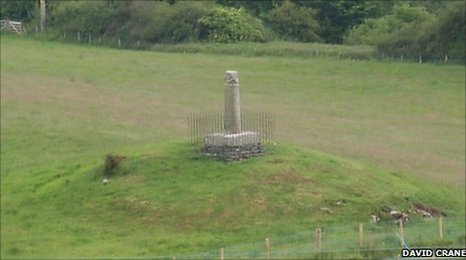
The Pillar of Eliseg was moved to the site of a burial mound in the 18th Century
Archaeologists start excavations on a suspected ancient burial site to try to understand the significance of a Llangollen landmark on which it stands.
But the team will have to work carefully because the 9th Century Pillar of Eliseg, a Cadw-protected ancient monument, stands directly on top of the barrow - burial mound - and the archaeologists can't disturb it.
Medieval archaeology Professor Nancy Edwards, from Bangor University, says it is the first time the site has been dug since 1773 when, it is believed, a skeleton was unearthed.
"We are trying to date the barrow in its broader archaeological context," she said, as the site could date back to the Bronze Age.
The history behind the monument and why it was erected on the mound is not yet understood.
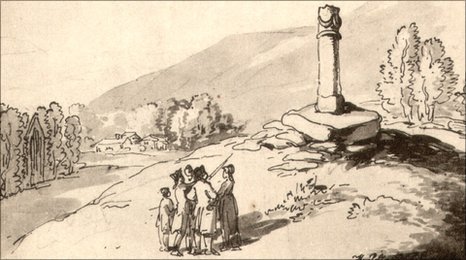
The earliest known picture of the pillar, dated 1797, courtesy Llangollen Museum
However, separate work has been carried out to try to decipher original and additional faded inscriptions by experts from the Royal Commission on the Ancient and Historical Monuments of Wales (RCAHMW).
It was originally a cross made to commemorate an early medieval leader, Eliseg (or Elisedd).
Today, only the shaft of the cross remains and its inscription, which was already almost illegible when the antiquary Edward Lhuyd tried to transcribe it in 1696, has disappeared.
Some of the 18th Century inscription added to the cross by Trevor Lloyd of Trevor Hall, who then owned the land, has since been discerned by the experts, but that didn't reveal any more about its history.
Joining Prof Edwards on-site for the dig will be colleagues from the University of Chester and with help from Llangollen Museum.
The plan is to open one small trench within the barrow and three others in close proximity within the field which is owned by a private landowner.
Dai Morgan Evans, visiting professor in archaeology at Chester University, is looking forward to the dig.
 Valle Crucis Abbey
Valle Crucis Abbey 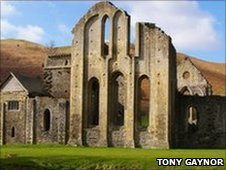
 Abbey and the Holy Grail legends
Abbey and the Holy Grail legends
He told the Leader newspaper that Trevor Lloyd, the 17th Century landowner, could have added to the inscription to imply he was related to the Welsh king named on the inscription and those in the burial below.
During the dig, David Crane and Sue Evans from Llangollen Museum plan to give daily updates via the museum's Facebook page, along with members of the dig team.
And the public will be allowed on-site during an open day (31 July), between 11am-3pm.
*******************
This is how I connect to Welsh princes:
…Cynan, King of Powys
…Salyf Sarff Cedau
…Mael Mynan
…Beli
…Gwallawg
…Eliseg
…Brochwel II of Powys
…Cadel II, Prince of Powys, ruled 804-829
…Cadel III, Prince of Powys m. daughter of Howel
…Uriel, son of Elidur, son of Roderick Melwynog King of Gwynedd, (Uriel m. Nest daughter of Cadel III)
Mervyn Verch, Prince of Gwynedd
…Rhodri Mawr ap Mervyn m. Angharad
/Llywarch Ap Elidir
/Dwywg Ap Llywarch
/Gwair Ap Dwywg
/Tegid Ap Gwair
/Alewyn Ap Tegid
/Sandde Ap Alewyn
/Elidir Ap Sandde
/Gwriad "Of Man" Ap Elidir b: 0738 d: 0825
/Mervyn Frych "the Freckl" Ap Gwriad b: 0764
| | /Brochwell II Ap Elisse (Eliseg) Eliseg was gggf of Rhodri
| | /Cadell II Ap Brodwell b: ? 0725 d: ABT 0809
| \Nest Verch Cadell b: 0742
Rhodri Mawr "The Great" Ap Mervyn b: 0789 d: 0878
| /Cadwalladr "The Great" Ap Cadwallon b: 0615
| /Idwal Iwrch Ap Cadwaladr b: ABT 0664
| /Rhodri Molwynog Ap Idwal b: 0690
| | \Agatha de Bretagne b: ABT 0685
| /Cynan Dindaethwy Ap Rhodri b: 0745
\Esyllt Verch Cynan b: 0770
\Matilda of Flint
…Anarawd ap Rhodri
…Idwal Foel ap Anarawd (Idwal the Bald)
…Meurig
…Idwal
…Iago, Prince of Gwynedd
…Cynan ap Iago m. Ragnaillt, the daughter of Olaf of Dublin, son of King Sigtrygg Silkbeard and a member of the Hiberno-Norse dynasty.
…Gruffydd ap Cynan, King of Gwynedd, m. Angharad ferch Owain, was the daughter of
…Owain ab Edwin
…Owain Gwynedd, king of Gwynedd, m. Gwladys (Gladys) ferch Llywarch
…Iorwerth Drwyndwn m. Marared ferch Madog
…Llywelyn ab Iorwerth, the Great, Prince of Wales, 1173-1240, m. Joan, Lady of Wales/Joan Plantagenet, daughter of King John and Isabella of Angouleme
both of Llywelyn's daughters are my ancestors:
1. Elen ferch Llywelyn (c.1207–1253) married Sir Robert de Quincy
2. Gwladus Ddu (c.1206–1251), m. Ralph de Mortimer of Wigmore and had several sons
I descend through both Elen and Gwladus, and possibly other children of Llywelyn. Many of his children married into Marcher families who were my ancestors.
Another link to Eliseg's Pillar: http://www.castlewales.com/eliseg.html

Pillar of Eliseg: Archaeologists dig beneath 9th Century monument

The Pillar of Eliseg was moved to the site of a burial mound in the 18th Century
Archaeologists start excavations on a suspected ancient burial site to try to understand the significance of a Llangollen landmark on which it stands.
But the team will have to work carefully because the 9th Century Pillar of Eliseg, a Cadw-protected ancient monument, stands directly on top of the barrow - burial mound - and the archaeologists can't disturb it.
Medieval archaeology Professor Nancy Edwards, from Bangor University, says it is the first time the site has been dug since 1773 when, it is believed, a skeleton was unearthed.
"We are trying to date the barrow in its broader archaeological context," she said, as the site could date back to the Bronze Age.
The history behind the monument and why it was erected on the mound is not yet understood.

The earliest known picture of the pillar, dated 1797, courtesy Llangollen Museum
However, separate work has been carried out to try to decipher original and additional faded inscriptions by experts from the Royal Commission on the Ancient and Historical Monuments of Wales (RCAHMW).
It was originally a cross made to commemorate an early medieval leader, Eliseg (or Elisedd).
Today, only the shaft of the cross remains and its inscription, which was already almost illegible when the antiquary Edward Lhuyd tried to transcribe it in 1696, has disappeared.
Some of the 18th Century inscription added to the cross by Trevor Lloyd of Trevor Hall, who then owned the land, has since been discerned by the experts, but that didn't reveal any more about its history.
Joining Prof Edwards on-site for the dig will be colleagues from the University of Chester and with help from Llangollen Museum.
The plan is to open one small trench within the barrow and three others in close proximity within the field which is owned by a private landowner.
Dai Morgan Evans, visiting professor in archaeology at Chester University, is looking forward to the dig.
 Valle Crucis Abbey
Valle Crucis Abbey 
 Abbey and the Holy Grail legends
Abbey and the Holy Grail legends He told the Leader newspaper that Trevor Lloyd, the 17th Century landowner, could have added to the inscription to imply he was related to the Welsh king named on the inscription and those in the burial below.
During the dig, David Crane and Sue Evans from Llangollen Museum plan to give daily updates via the museum's Facebook page, along with members of the dig team.
And the public will be allowed on-site during an open day (31 July), between 11am-3pm.
*******************
This is how I connect to Welsh princes:
…Cynan, King of Powys
…Salyf Sarff Cedau
…Mael Mynan
…Beli
…Gwallawg
…Eliseg
…Brochwel II of Powys
…Cadel II, Prince of Powys, ruled 804-829
…Cadel III, Prince of Powys m. daughter of Howel
…Uriel, son of Elidur, son of Roderick Melwynog King of Gwynedd, (Uriel m. Nest daughter of Cadel III)
Mervyn Verch, Prince of Gwynedd
…Rhodri Mawr ap Mervyn m. Angharad
/Llywarch Ap Elidir
/Dwywg Ap Llywarch
/Gwair Ap Dwywg
/Tegid Ap Gwair
/Alewyn Ap Tegid
/Sandde Ap Alewyn
/Elidir Ap Sandde
/Gwriad "Of Man" Ap Elidir b: 0738 d: 0825
/Mervyn Frych "the Freckl" Ap Gwriad b: 0764
| | /Brochwell II Ap Elisse (Eliseg) Eliseg was gggf of Rhodri
| | /Cadell II Ap Brodwell b: ? 0725 d: ABT 0809
| \Nest Verch Cadell b: 0742
Rhodri Mawr "The Great" Ap Mervyn b: 0789 d: 0878
| /Cadwalladr "The Great" Ap Cadwallon b: 0615
| /Idwal Iwrch Ap Cadwaladr b: ABT 0664
| /Rhodri Molwynog Ap Idwal b: 0690
| | \Agatha de Bretagne b: ABT 0685
| /Cynan Dindaethwy Ap Rhodri b: 0745
\Esyllt Verch Cynan b: 0770
\Matilda of Flint
…Anarawd ap Rhodri
…Idwal Foel ap Anarawd (Idwal the Bald)
…Meurig
…Idwal
…Iago, Prince of Gwynedd
…Cynan ap Iago m. Ragnaillt, the daughter of Olaf of Dublin, son of King Sigtrygg Silkbeard and a member of the Hiberno-Norse dynasty.
…Gruffydd ap Cynan, King of Gwynedd, m. Angharad ferch Owain, was the daughter of
…Owain ab Edwin
…Owain Gwynedd, king of Gwynedd, m. Gwladys (Gladys) ferch Llywarch
…Iorwerth Drwyndwn m. Marared ferch Madog
…Llywelyn ab Iorwerth, the Great, Prince of Wales, 1173-1240, m. Joan, Lady of Wales/Joan Plantagenet, daughter of King John and Isabella of Angouleme
both of Llywelyn's daughters are my ancestors:
1. Elen ferch Llywelyn (c.1207–1253) married Sir Robert de Quincy
2. Gwladus Ddu (c.1206–1251), m. Ralph de Mortimer of Wigmore and had several sons
I descend through both Elen and Gwladus, and possibly other children of Llywelyn. Many of his children married into Marcher families who were my ancestors.
Another link to Eliseg's Pillar: http://www.castlewales.com/eliseg.html
Published on July 22, 2010 17:47

